小白学Pytorch系列–Torch API (10)

BLAS and LAPACK Operations
addbmm
执行存储在batch1和batch2中的矩阵的批处理矩阵矩阵乘积,并减少加法步骤(所有矩阵乘法都沿第一维累加)。将输入添加到最终结果中。
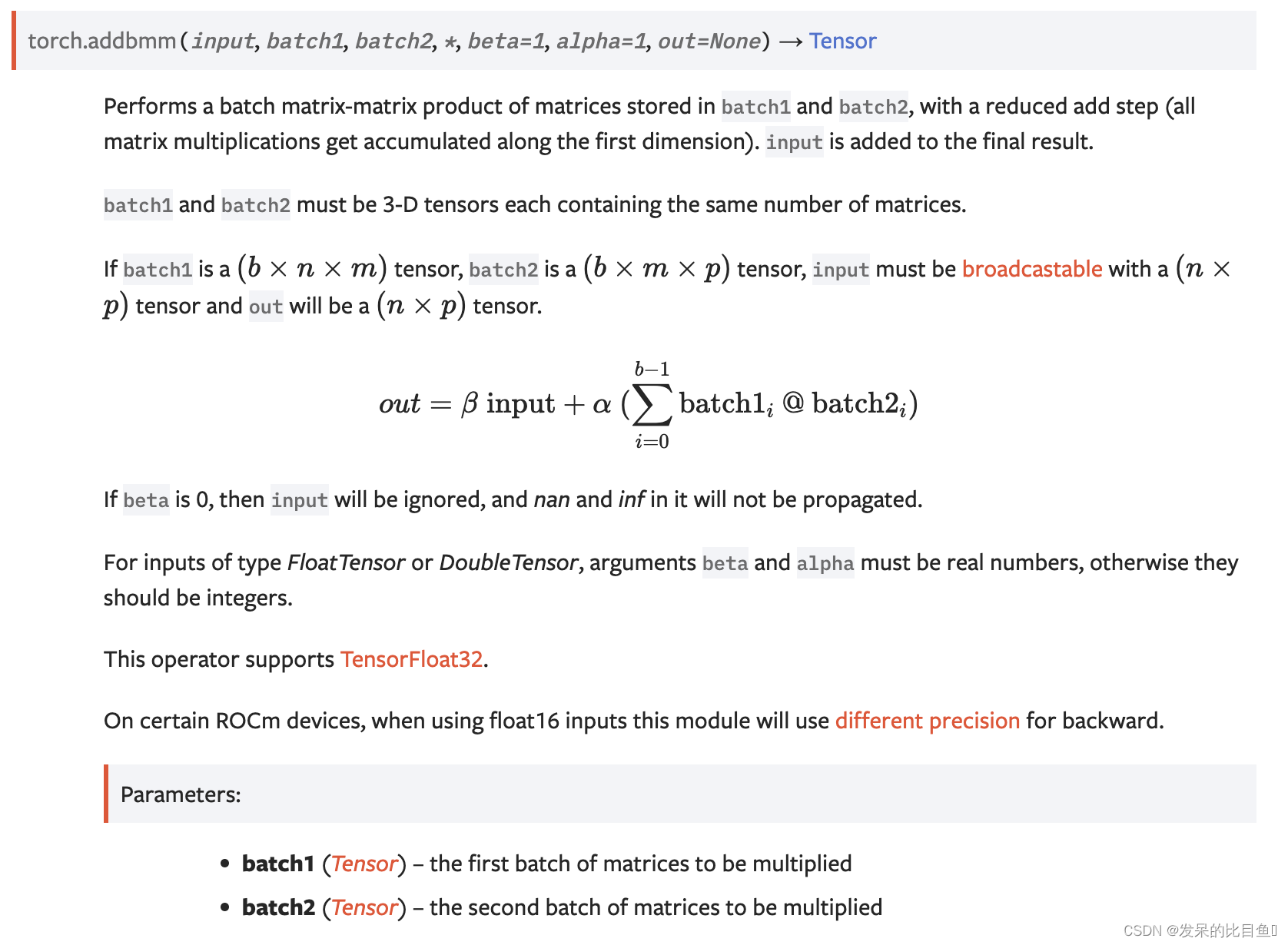
>>> M = torch.randn(3, 5)
>>> batch1 = torch.randn(10, 3, 4)
>>> batch2 = torch.randn(10, 4, 5)
>>> torch.addbmm(M, batch1, batch2)
tensor([[ 6.6311, 0.0503, 6.9768, -12.0362, -2.1653],
[ -4.8185, -1.4255, -6.6760, 8.9453, 2.5743],
[ -3.8202, 4.3691, 1.0943, -1.1109, 5.4730]])
addmm
对矩阵mat1和mat2执行矩阵乘法运算。矩阵输入被添加到最终结果中。


>>> M = torch.randn(2, 3)
>>> mat1 = torch.randn(2, 3)
>>> mat2 = torch.randn(3, 3)
>>> torch.addmm(M, mat1, mat2)
tensor([[-4.8716, 1.4671, -1.3746],
[ 0.7573, -3.9555, -2.8681]])
addmv
执行矩阵矩阵和向量vec的矩阵向量乘积。将矢量输入添加到最终结果中
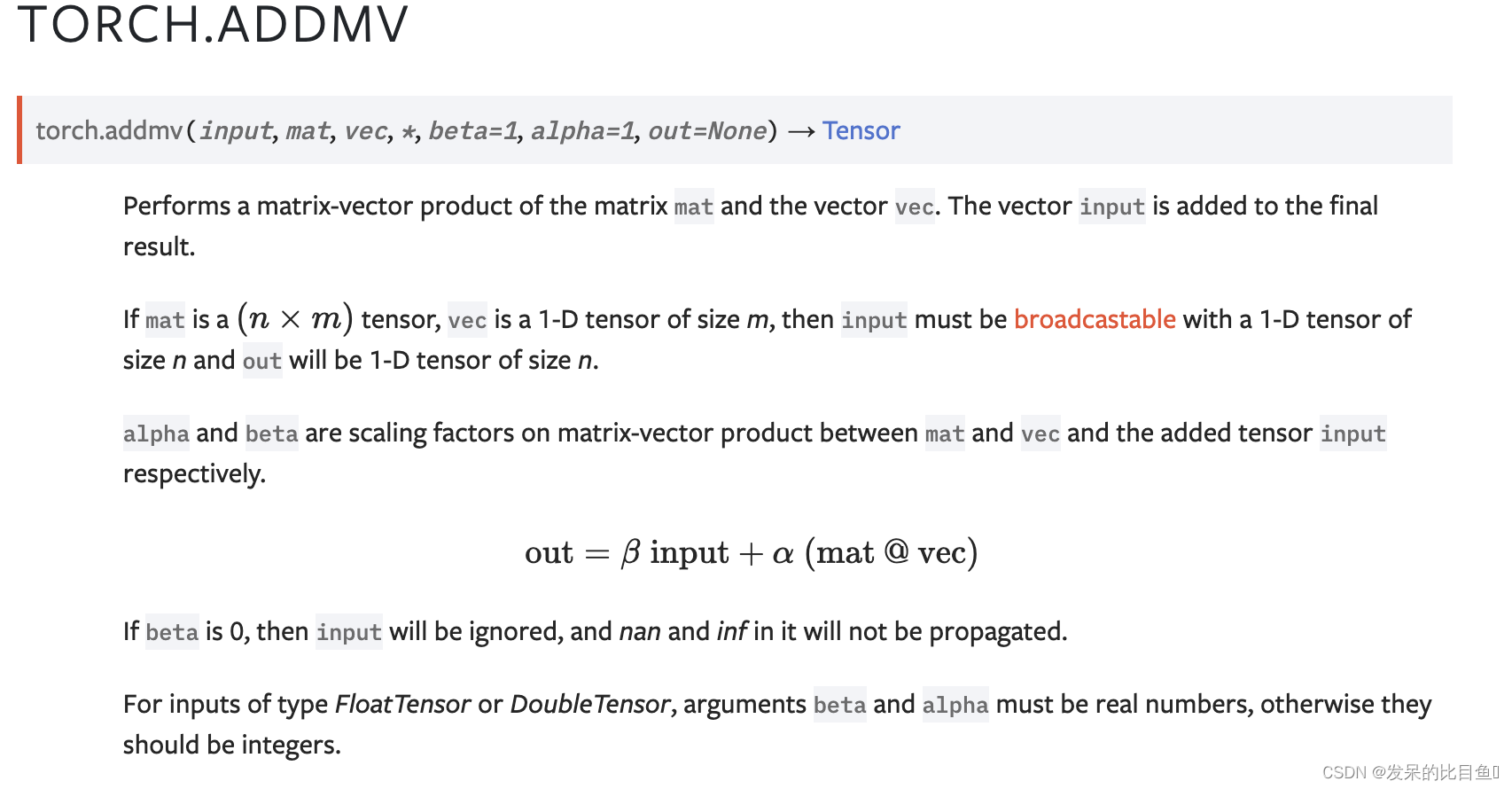

>>> M = torch.randn(2)
>>> mat = torch.randn(2, 3)
>>> vec = torch.randn(3)
>>> torch.addmv(M, mat, vec)
tensor([-0.3768, -5.5565])
addr
执行向量vec1和vec2的外积,并将其添加到矩阵输入。

>>> vec1 = torch.arange(1., 4.)
>>> vec2 = torch.arange(1., 3.)
>>> M = torch.zeros(3, 2)
>>> torch.addr(M, vec1, vec2)
tensor([[ 1., 2.],
[ 2., 4.],
[ 3., 6.]])
baddbmm
执行批次1和批次2中矩阵的批次矩阵矩阵乘积。将输入添加到最终结果中。
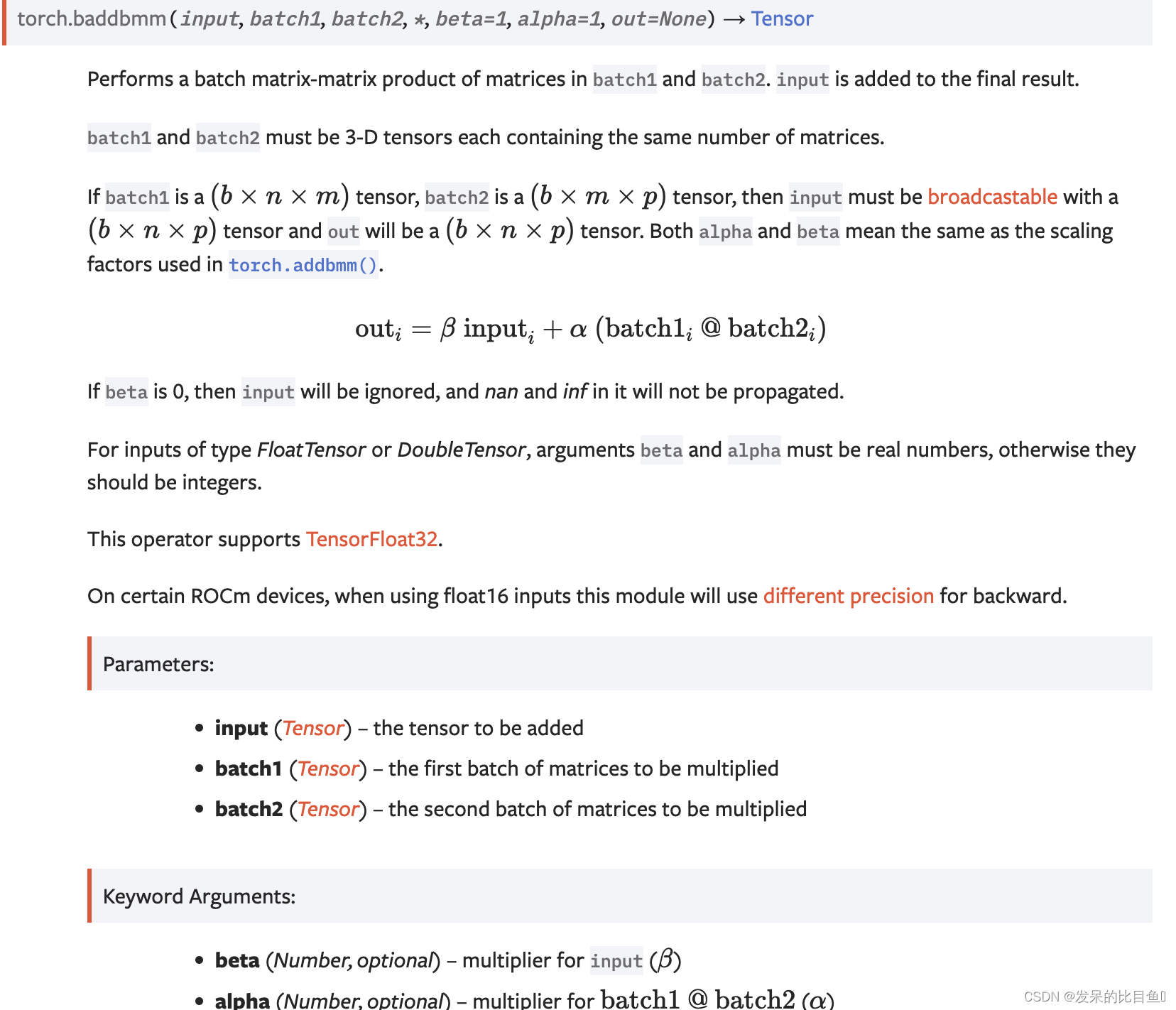
>>> M = torch.randn(10, 3, 5)
>>> batch1 = torch.randn(10, 3, 4)
>>> batch2 = torch.randn(10, 4, 5)
>>> torch.baddbmm(M, batch1, batch2).size()
torch.Size([10, 3, 5])
bmm
执行存储在input和mat2中的矩阵的批处理矩阵矩阵乘积。
input和mat2必须是3-D张量,每个张量都包含相同数量的矩阵。
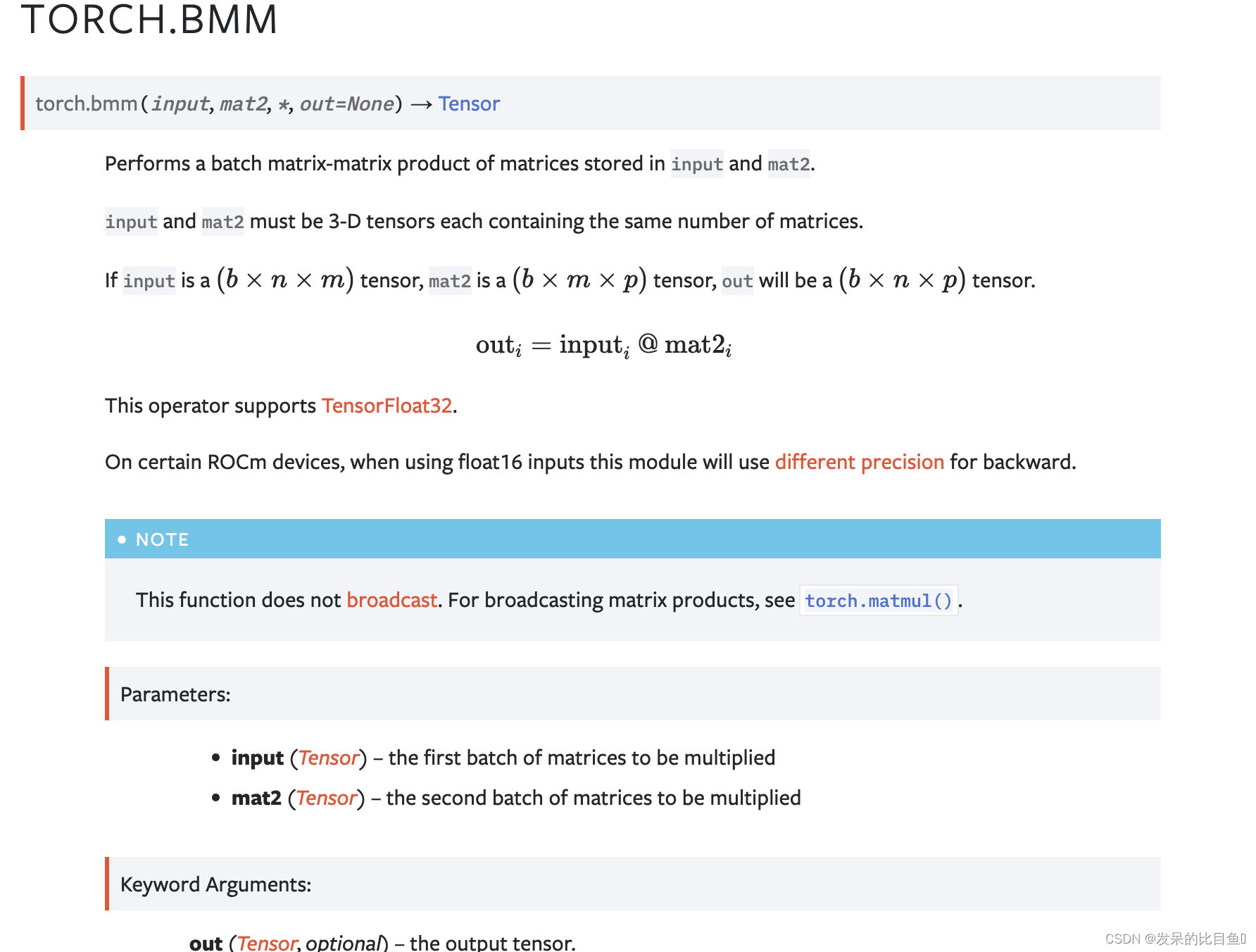
>>> input = torch.randn(10, 3, 4)
>>> mat2 = torch.randn(10, 4, 5)
>>> res = torch.bmm(input, mat2)
>>> res.size()
torch.Size([10, 3, 5])
chain_matmul
返回N个二维张量的矩阵乘积。该乘积是使用矩阵链顺序算法有效计算的,该算法选择在算术运算([CLRS])方面产生最低成本的顺序。注意,由于这是一个计算乘积的函数,因此N需要大于或等于2;如果等于2,则返回平凡矩阵矩阵乘积。如果N是1,那么这是一个无运算-原始矩阵按原样返回。
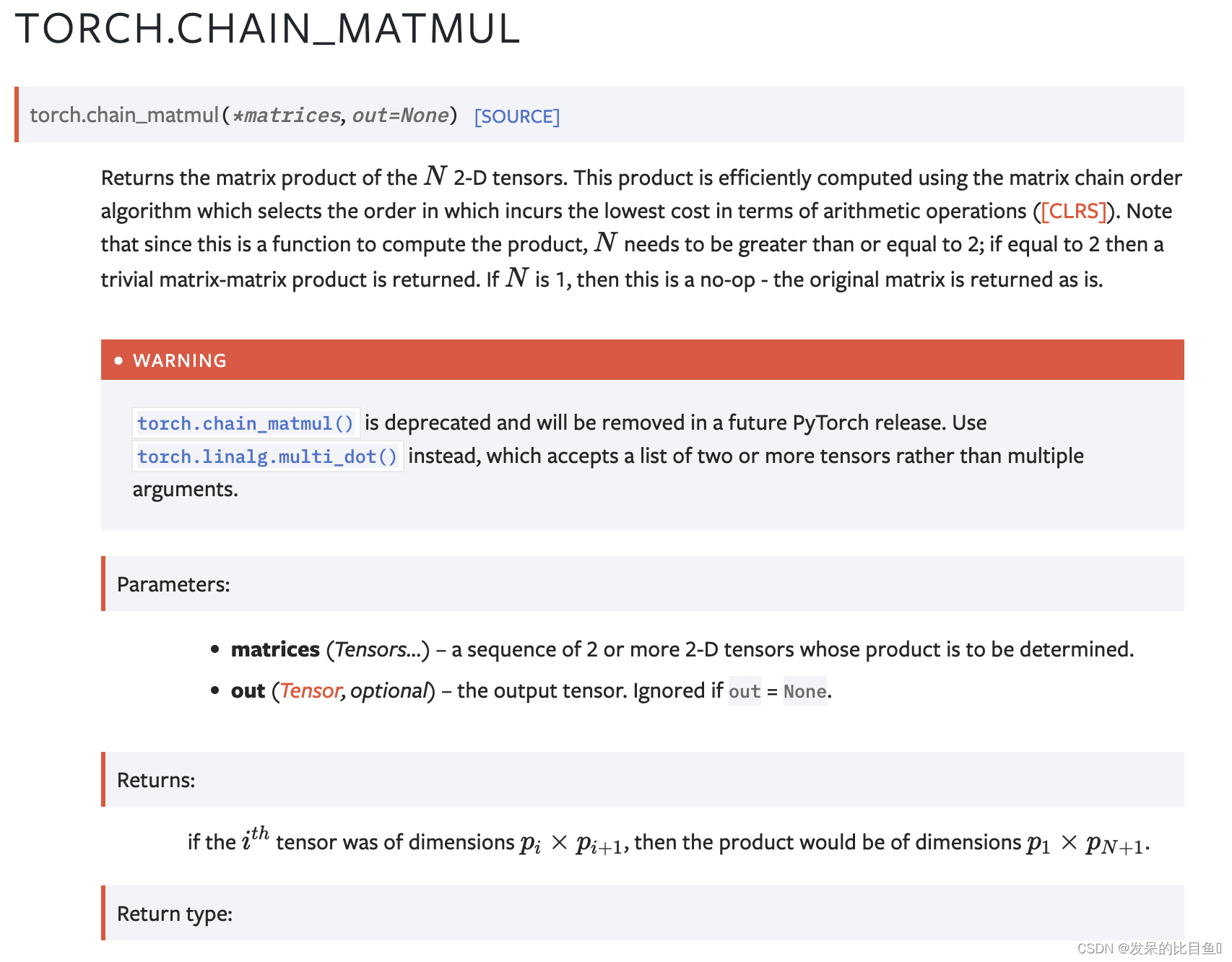
>>> a = torch.randn(3, 4)
>>> b = torch.randn(4, 5)
>>> c = torch.randn(5, 6)
>>> d = torch.randn(6, 7)
>>> # will raise a deprecation warning
>>> torch.chain_matmul(a, b, c, d)
tensor([[ -2.3375, -3.9790, -4.1119, -6.6577, 9.5609, -11.5095, -3.2614],
[ 21.4038, 3.3378, -8.4982, -5.2457, -10.2561, -2.4684, 2.7163],
[ -0.9647, -5.8917, -2.3213, -5.2284, 12.8615, -12.2816, -2.5095]])
cholesky
计算对称正定矩阵A或一批对称正定矩阵的Cholesky分解。
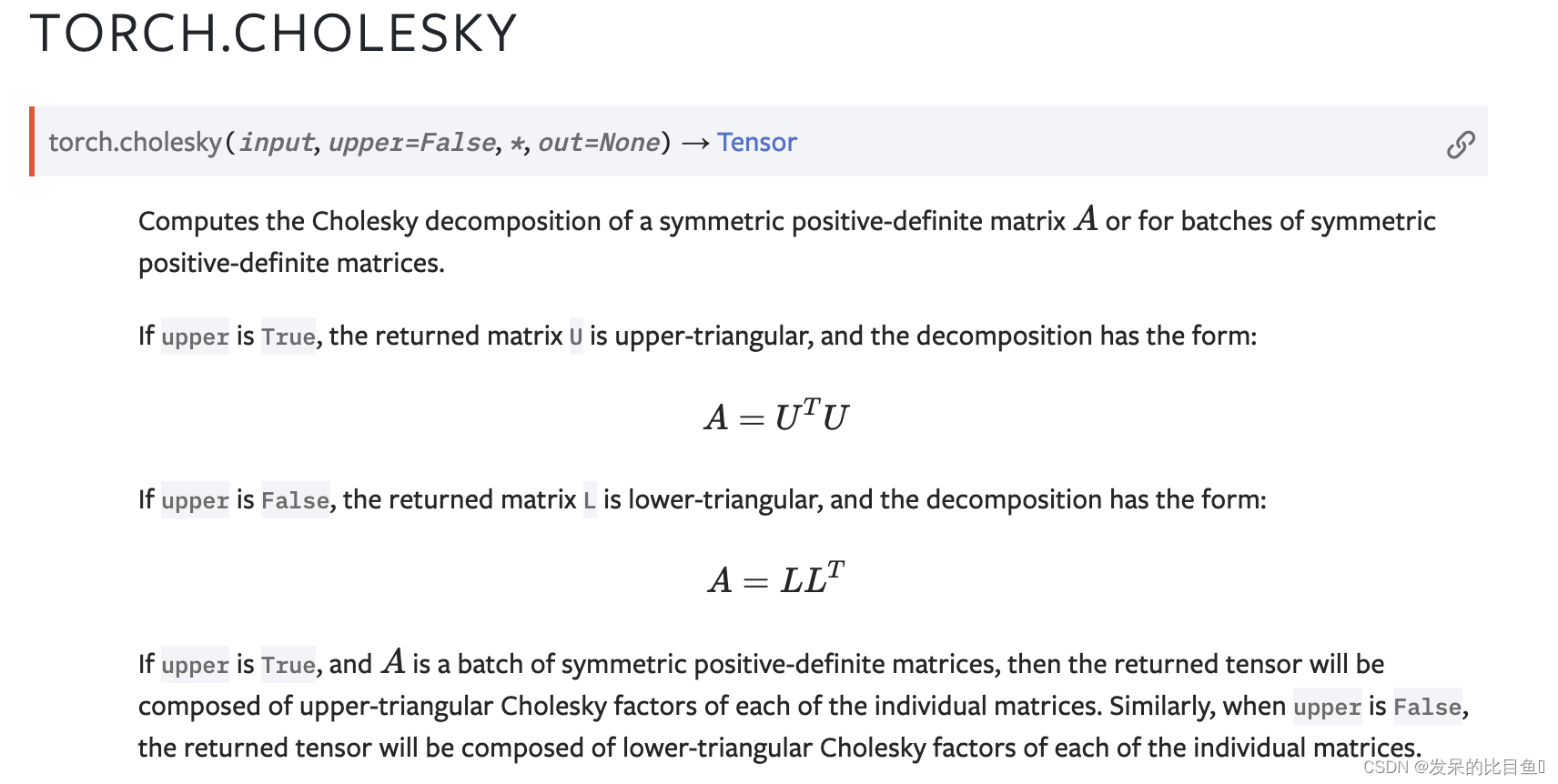
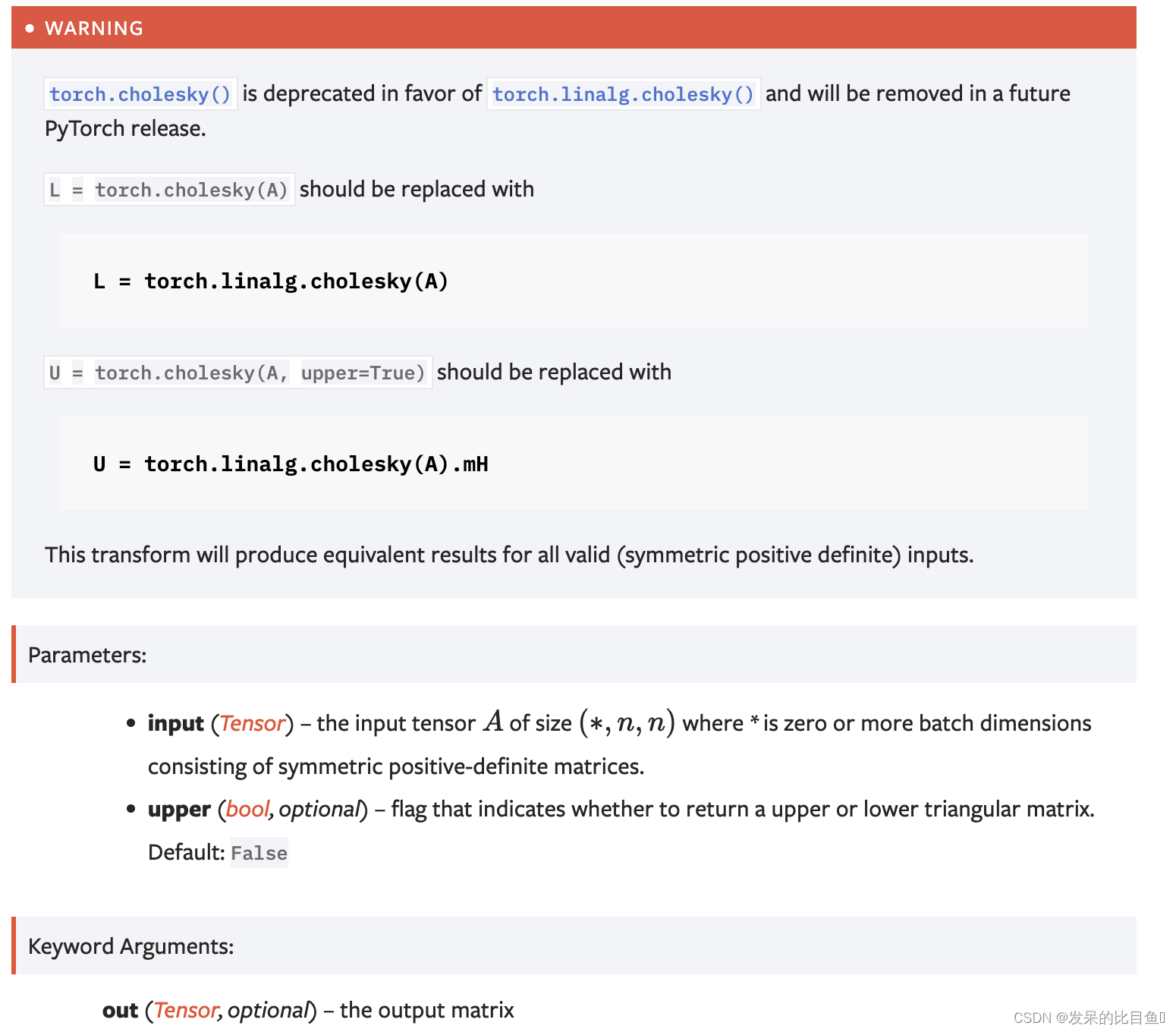
功能:
计算对称正定矩阵的Cholesky分解。A 或对于成批的对称正定矩阵。
如果 upper 为 True ,则返回的矩阵 U 为上三角,分解形式为:
A
=
U
T
U
A=U^TU
A=UTU
如果 upper 为 False ,则返回的矩阵 L 为下三角,分解形式为:
A
=
L
L
T
A=LL^T
A=LLT
如果 upper 为 True ,并且A 是一组对称的正定矩阵,则返回的张量将由各个矩阵的上三角Cholesky因子组成。同样,当 upper 为 False 时,返回的张量将由各个矩阵的下三角Cholesky因子组成。
注意:
torch.linalg.cholesky() 如果可能,应该在 torch.cholesky 上使用torch.linalg.cholesky()。但是请注意, torch.linalg.cholesky() 尚不支持 upper 参数,而是始终返回下三角矩阵。
Parameters
input(张量)–输入张量A 大小(*, n, n) 其中 * 是零个或多个由对称正定矩阵组成的批处理维。
upper(bool ,可选)–指示是否返回上三角矩阵或下三角矩阵的标志。默认值: False
输出:
out(Tensor ,可选)–输出矩阵
>>> a = torch.randn(3, 3)
>>> a = a @ a.mT + 1e-3 # make symmetric positive-definite 使对称正定
>>> l = torch.cholesky(a)
>>> a
tensor([[ 2.4112, -0.7486, 1.4551],
[-0.7486, 1.3544, 0.1294],
[ 1.4551, 0.1294, 1.6724]])
>>> l
tensor([[ 1.5528, 0.0000, 0.0000],
[-0.4821, 1.0592, 0.0000],
[ 0.9371, 0.5487, 0.7023]])
>>> l @ l.mT
tensor([[ 2.4112, -0.7486, 1.4551],
[-0.7486, 1.3544, 0.1294],
[ 1.4551, 0.1294, 1.6724]])
>>> a = torch.randn(3, 2, 2) # Example for batched input
>>> a = a @ a.mT + 1e-03 # make symmetric positive-definite
>>> l = torch.cholesky(a)
>>> z = l @ l.mT
>>> torch.dist(z, a)
tensor(2.3842e-07)
cholesky_inverse
使用Cholesky因子U计算对称正定矩阵A的逆:返回矩阵inv。逆是使用LAPACK例程dpotri和spotri(以及相应的MAGMA例程)计算的。
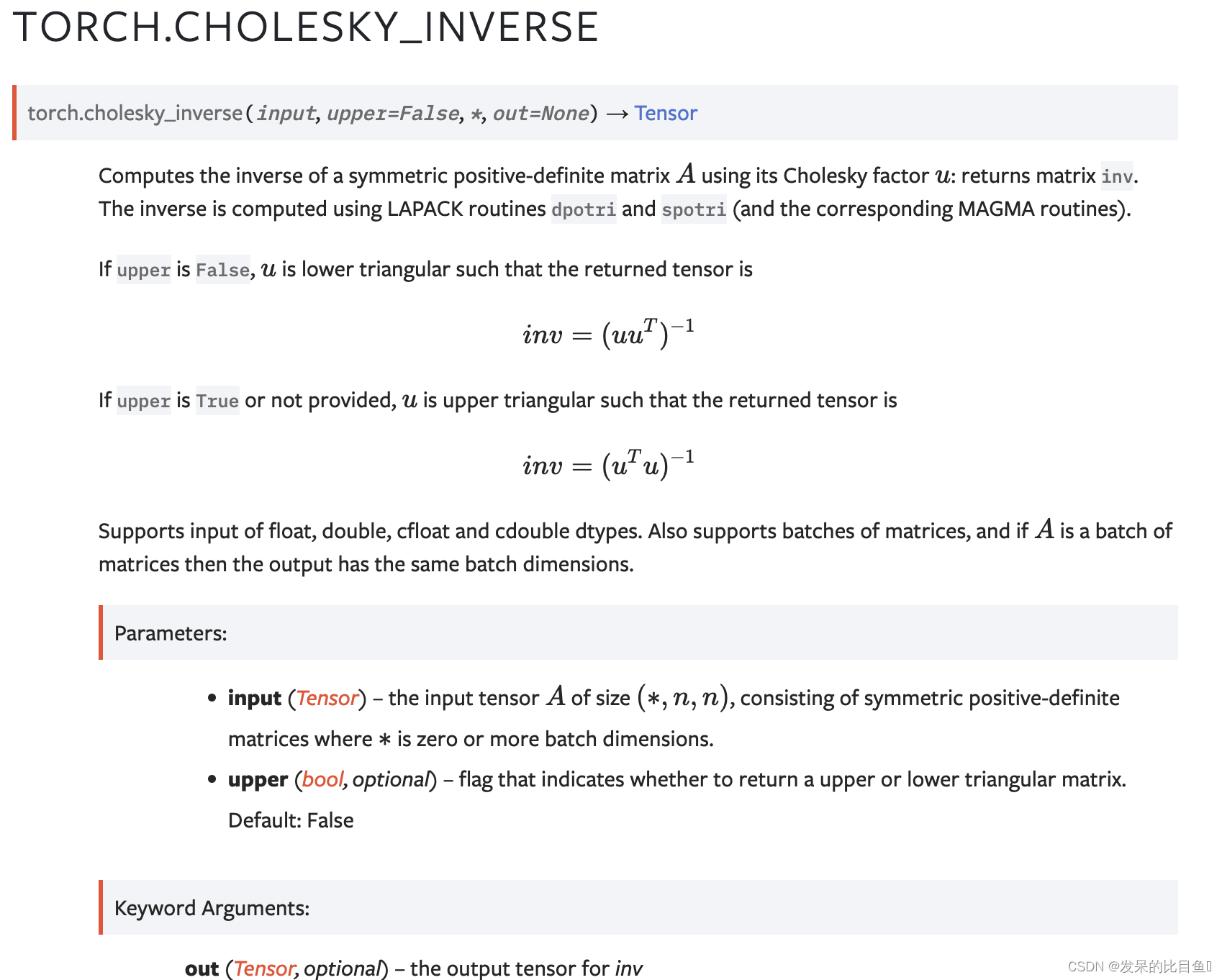
>>> a = torch.randn(3, 3)
>>> a = torch.mm(a, a.t()) + 1e-05 * torch.eye(3) # make symmetric positive definite
>>> u = torch.linalg.cholesky(a)
>>> a
tensor([[ 0.9935, -0.6353, 1.5806],
[ -0.6353, 0.8769, -1.7183],
[ 1.5806, -1.7183, 10.6618]])
>>> torch.cholesky_inverse(u)
tensor([[ 1.9314, 1.2251, -0.0889],
[ 1.2251, 2.4439, 0.2122],
[-0.0889, 0.2122, 0.1412]])
>>> a.inverse()
tensor([[ 1.9314, 1.2251, -0.0889],
[ 1.2251, 2.4439, 0.2122],
[-0.0889, 0.2122, 0.1412]])
>>> a = torch.randn(3, 2, 2) # Example for batched input
>>> a = a @ a.mT + 1e-03 # make symmetric positive-definite
>>> l = torch.linalg.cholesky(a)
>>> z = l @ l.mT
>>> torch.dist(z, a)
tensor(3.5894e-07)
cholesky_solve
求解一个线性方程组,该方程组具有一个半正定矩阵,给定其Cholesky因子矩阵u。


>>> a = torch.randn(3, 3)
>>> a = torch.mm(a, a.t()) # make symmetric positive definite
>>> u = torch.linalg.cholesky(a)
>>> a
tensor([[ 0.7747, -1.9549, 1.3086],
[-1.9549, 6.7546, -5.4114],
[ 1.3086, -5.4114, 4.8733]])
>>> b = torch.randn(3, 2)
>>> b
tensor([[-0.6355, 0.9891],
[ 0.1974, 1.4706],
[-0.4115, -0.6225]])
>>> torch.cholesky_solve(b, u)
tensor([[ -8.1625, 19.6097],
[ -5.8398, 14.2387],
[ -4.3771, 10.4173]])
>>> torch.mm(a.inverse(), b)
tensor([[ -8.1626, 19.6097],
[ -5.8398, 14.2387],
[ -4.3771, 10.4173]])
dot
计算两个一维张量的点积。

>>> torch.dot(torch.tensor([2, 3]), torch.tensor([2, 1]))
tensor(7)
geqrf
这是一个用于直接调用LAPACK的geqrf的低级函数。此函数返回geqrf的LAPACK文档中定义的命名元组(a,tau)。
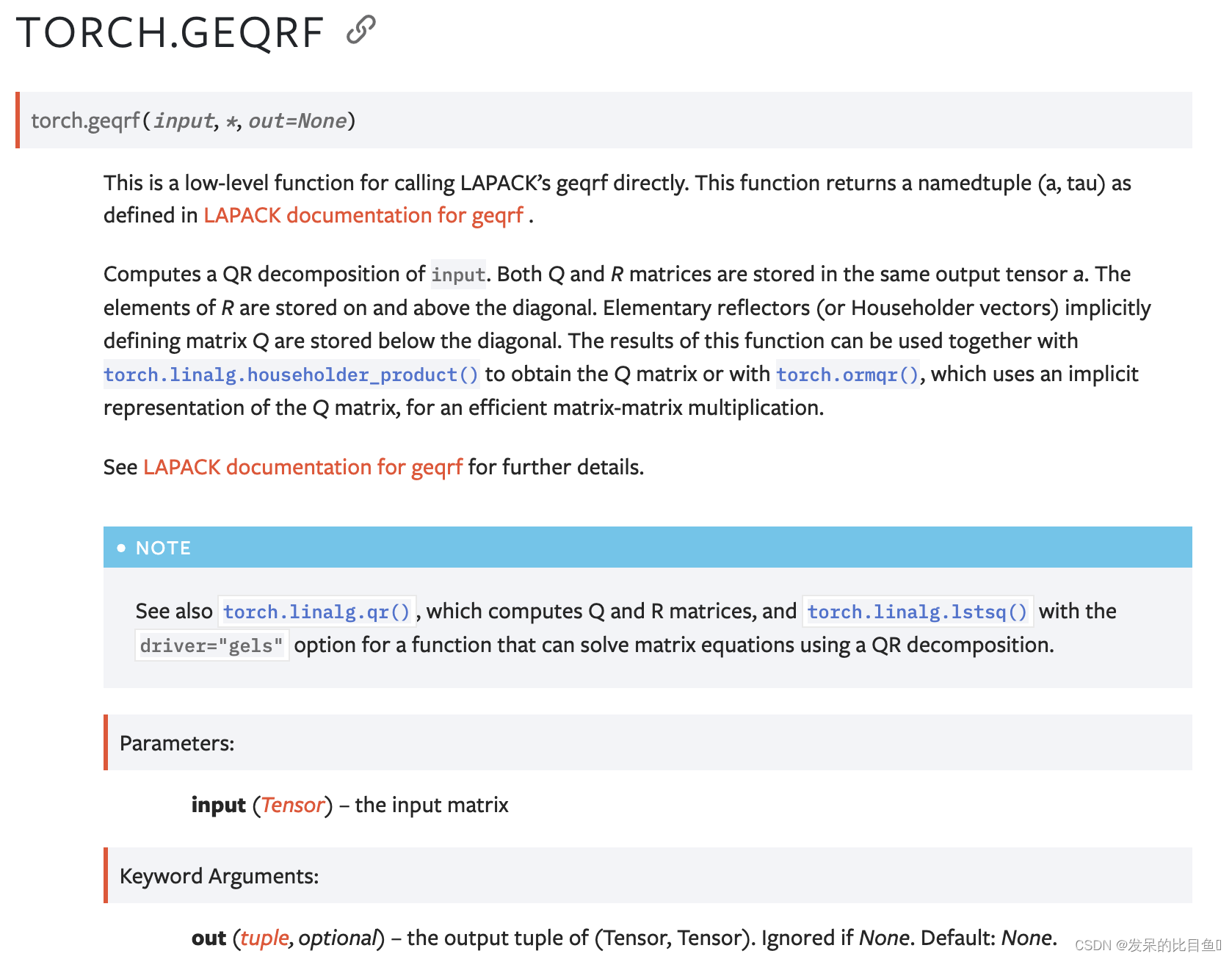
mat1 = torch.randn(10, 10)
q, r = torch.qr(mat1)
m, tau = torch.geqrf(mat1)
ger
torch.outer()的别名。
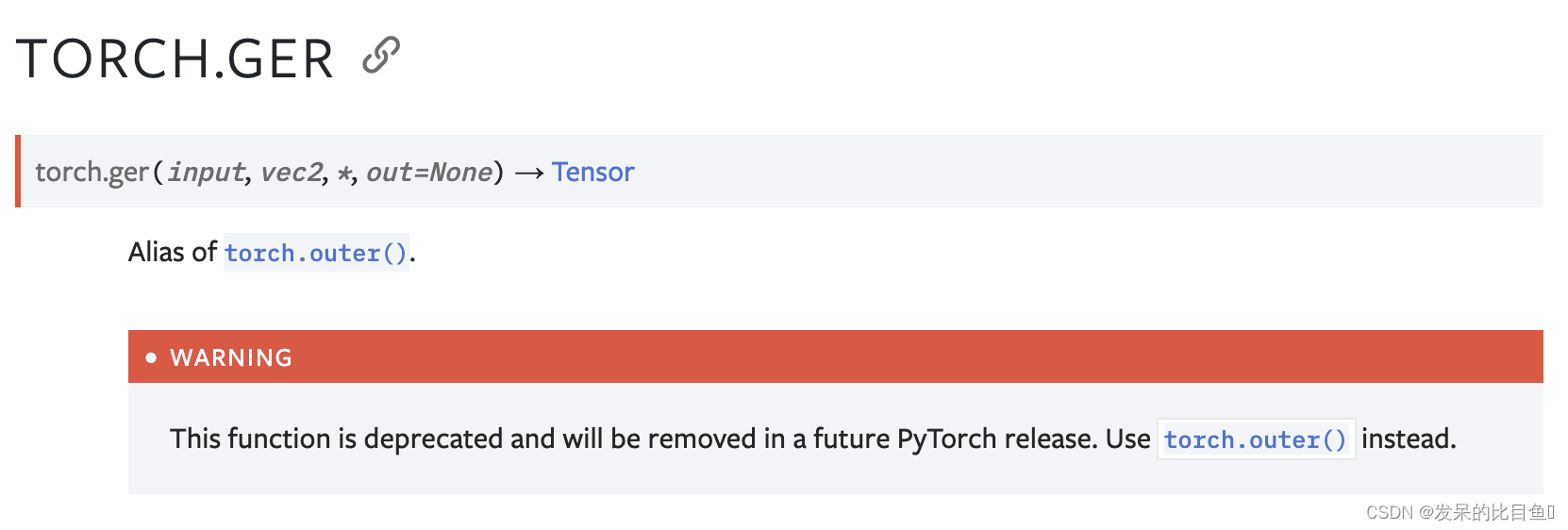
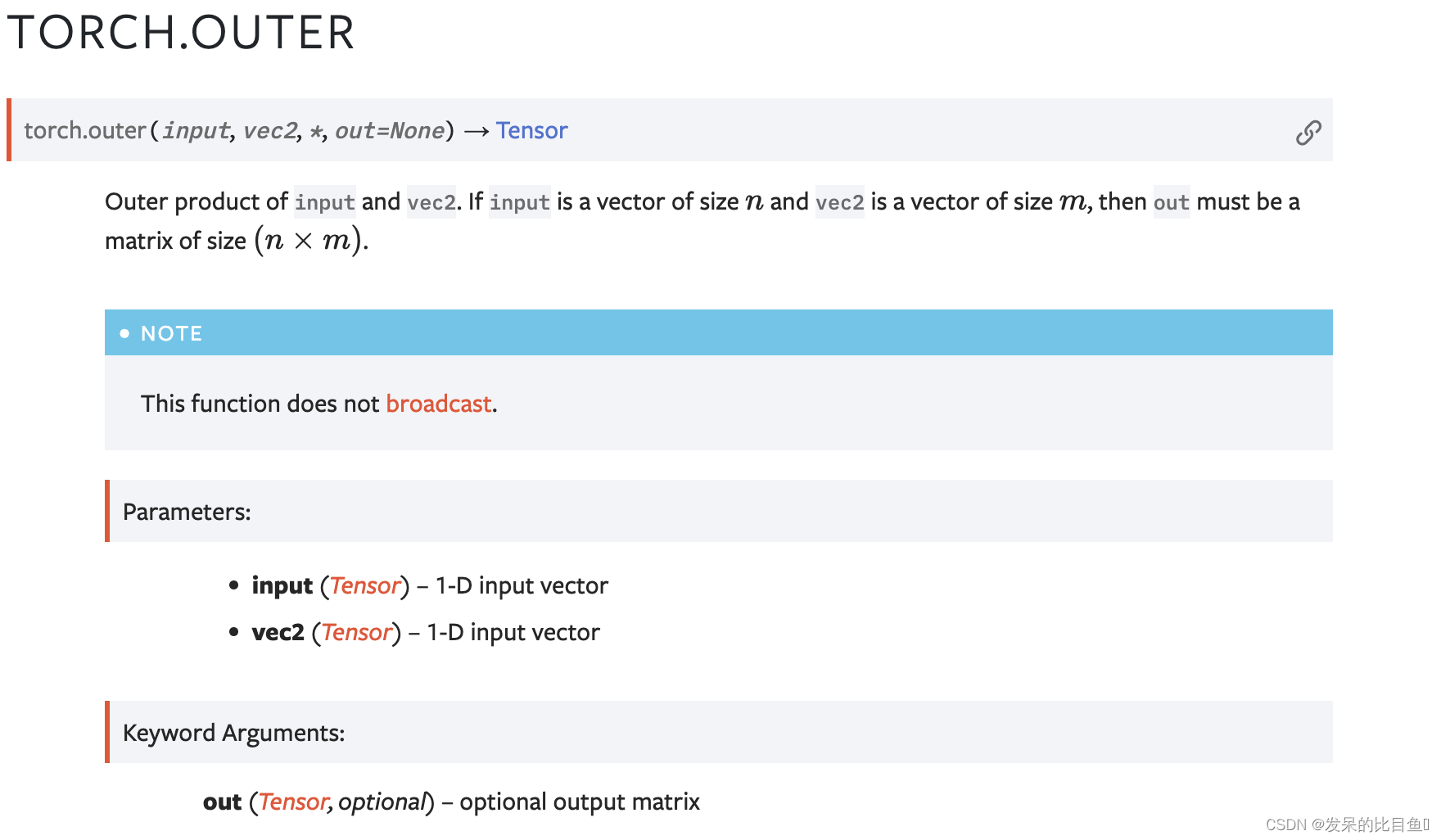
>>> v1 = torch.arange(1., 5.)
>>> v2 = torch.arange(1., 4.)
>>> torch.outer(v1, v2)
tensor([[ 1., 2., 3.],
[ 2., 4., 6.],
[ 3., 6., 9.],
[ 4., 8., 12.]])
inner
计算1D张量的点积。对于较高的维度,求输入元素和其他元素沿其最后一个维度的乘积。

# Dot product
>>> torch.inner(torch.tensor([1, 2, 3]), torch.tensor([0, 2, 1]))
tensor(7)
# Multidimensional input tensors
>>> a = torch.randn(2, 3)
>>> a
tensor([[0.8173, 1.0874, 1.1784],
[0.3279, 0.1234, 2.7894]])
>>> b = torch.randn(2, 4, 3)
>>> b
tensor([[[-0.4682, -0.7159, 0.1506],
[ 0.4034, -0.3657, 1.0387],
[ 0.9892, -0.6684, 0.1774],
[ 0.9482, 1.3261, 0.3917]],
[[ 0.4537, 0.7493, 1.1724],
[ 0.2291, 0.5749, -0.2267],
[-0.7920, 0.3607, -0.3701],
[ 1.3666, -0.5850, -1.7242]]])
>>> torch.inner(a, b)
tensor([[[-0.9837, 1.1560, 0.2907, 2.6785],
[ 2.5671, 0.5452, -0.6912, -1.5509]],
[[ 0.1782, 2.9843, 0.7366, 1.5672],
[ 3.5115, -0.4864, -1.2476, -4.4337]]])
# Scalar input
>>> torch.inner(a, torch.tensor(2))
tensor([[1.6347, 2.1748, 2.3567],
[0.6558, 0.2469, 5.5787]])
inverse
计算平方矩阵的逆矩阵(如果存在)。如果矩阵不可逆,则引发RuntimeError。
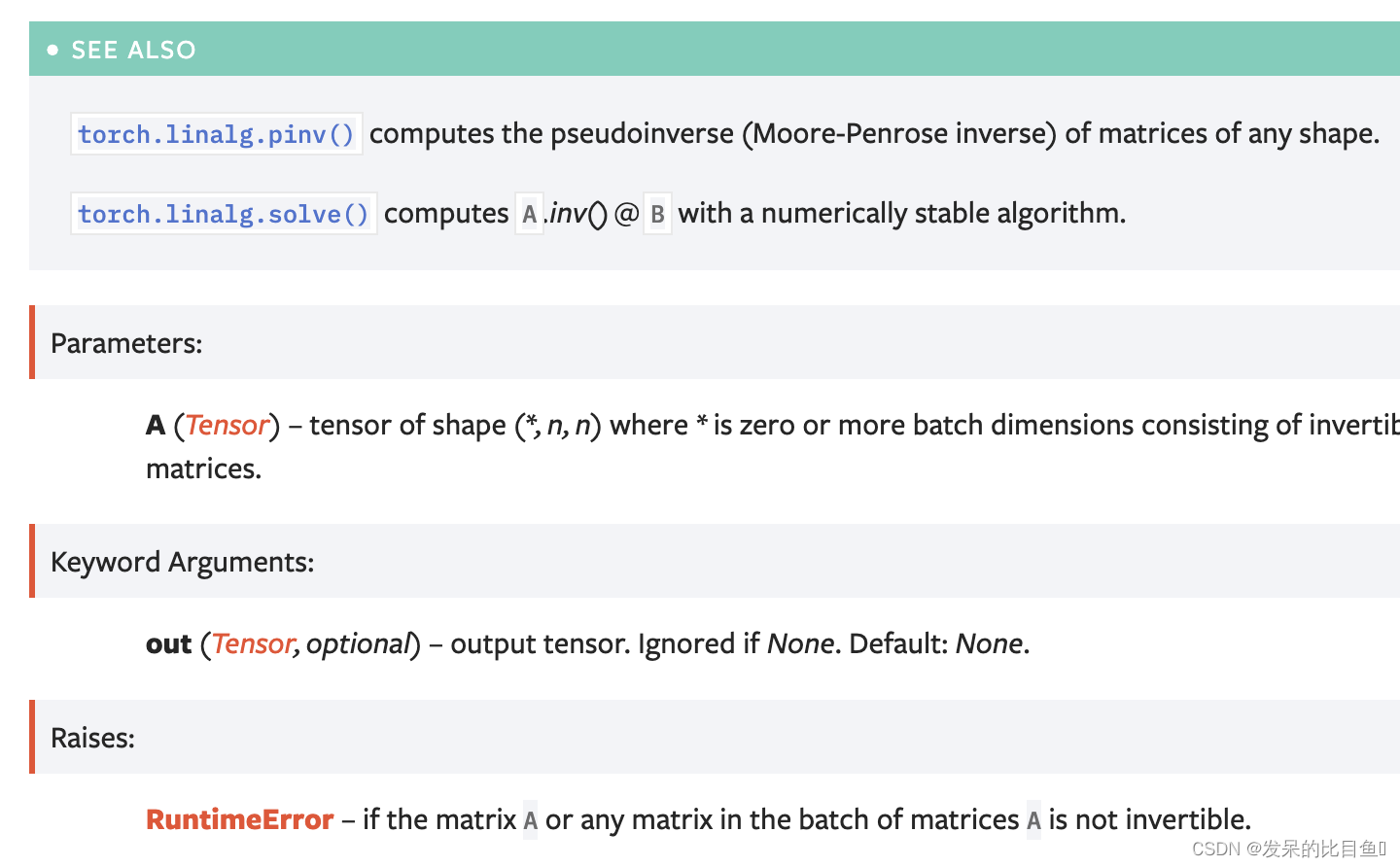

>>> A = torch.randn(4, 4)
>>> Ainv = torch.linalg.inv(A)
>>> torch.dist(A @ Ainv, torch.eye(4))
tensor(1.1921e-07)
>>> A = torch.randn(2, 3, 4, 4) # Batch of matrices
>>> Ainv = torch.linalg.inv(A)
>>> torch.dist(A @ Ainv, torch.eye(4))
tensor(1.9073e-06)
>>> A = torch.randn(4, 4, dtype=torch.complex128) # Complex matrix
>>> Ainv = torch.linalg.inv(A)
>>> torch.dist(A @ Ainv, torch.eye(4))
tensor(7.5107e-16, dtype=torch.float64)
det
计算一个平方矩阵的行列式。
支持float、double、cfloat和cddouble数据类型的输入。还支持批量矩阵,如果A是一批矩阵,则输出具有相同的批量维度。


>>> A = torch.randn(3, 3)
>>> torch.linalg.det(A)
tensor(0.0934)
>>> A = torch.randn(3, 2, 2)
>>> torch.linalg.det(A)
tensor([1.1990, 0.4099, 0.7386])
logdet
计算一个正方形矩阵或一批正方形矩阵的对数行列式。
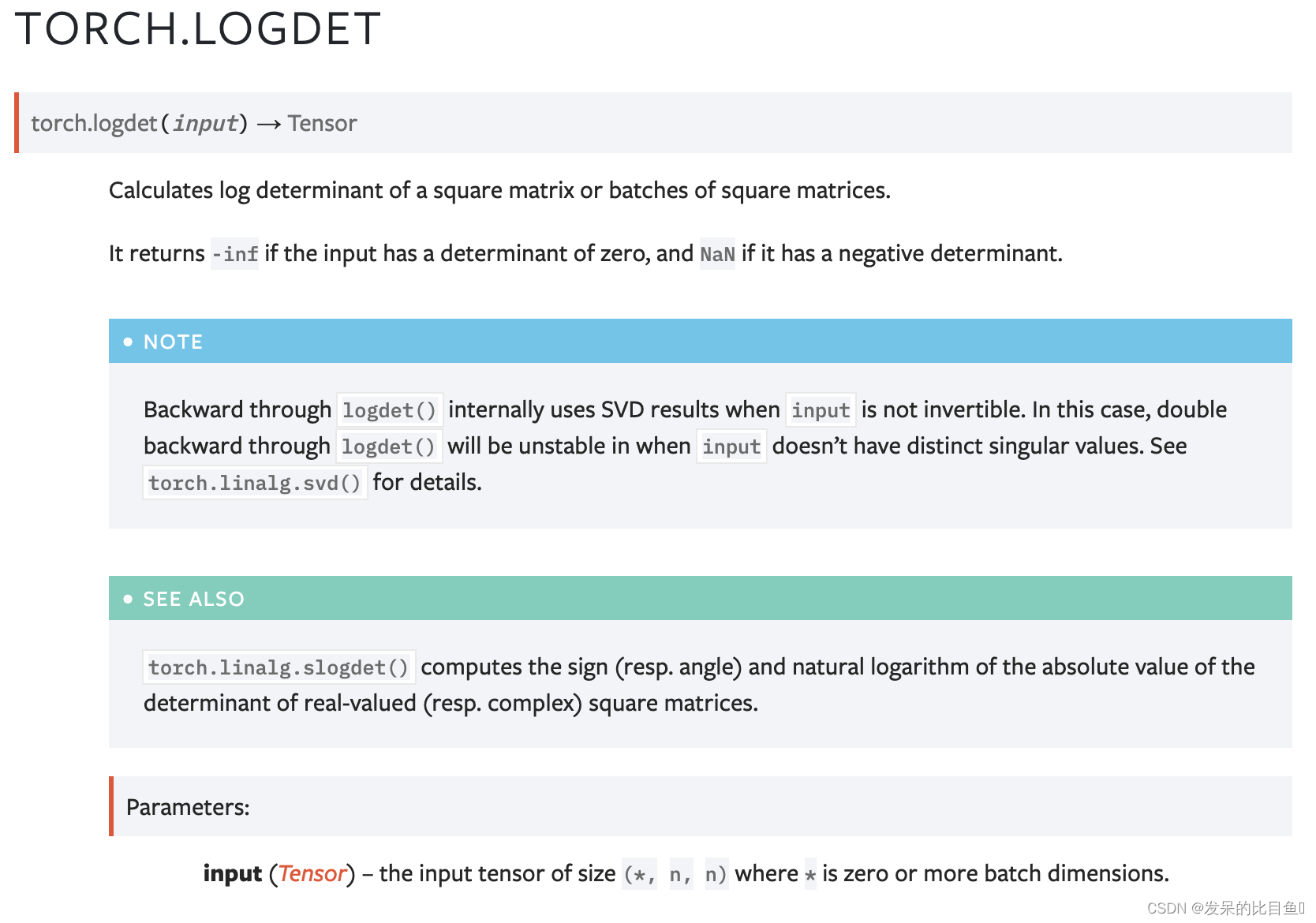
>>> A = torch.randn(3, 3)
>>> torch.det(A)
tensor(0.2611)
>>> torch.logdet(A)
tensor(-1.3430)
>>> A
tensor([[[ 0.9254, -0.6213],
[-0.5787, 1.6843]],
[[ 0.3242, -0.9665],
[ 0.4539, -0.0887]],
[[ 1.1336, -0.4025],
[-0.7089, 0.9032]]])
>>> A.det()
tensor([1.1990, 0.4099, 0.7386])
>>> A.det().log()
tensor([ 0.1815, -0.8917, -0.3031])
slogdet
torch.linalg.slogdet()的别名
计算一个平方矩阵的行列式的绝对值的符号和自然对数。
对于复数A,它返回行列式模的符号和自然对数,即行列式的对数极分解。
行列式可以恢复为符号*exp(logabsdet)。当矩阵的行列式为零时,它返回(0,-inf)。

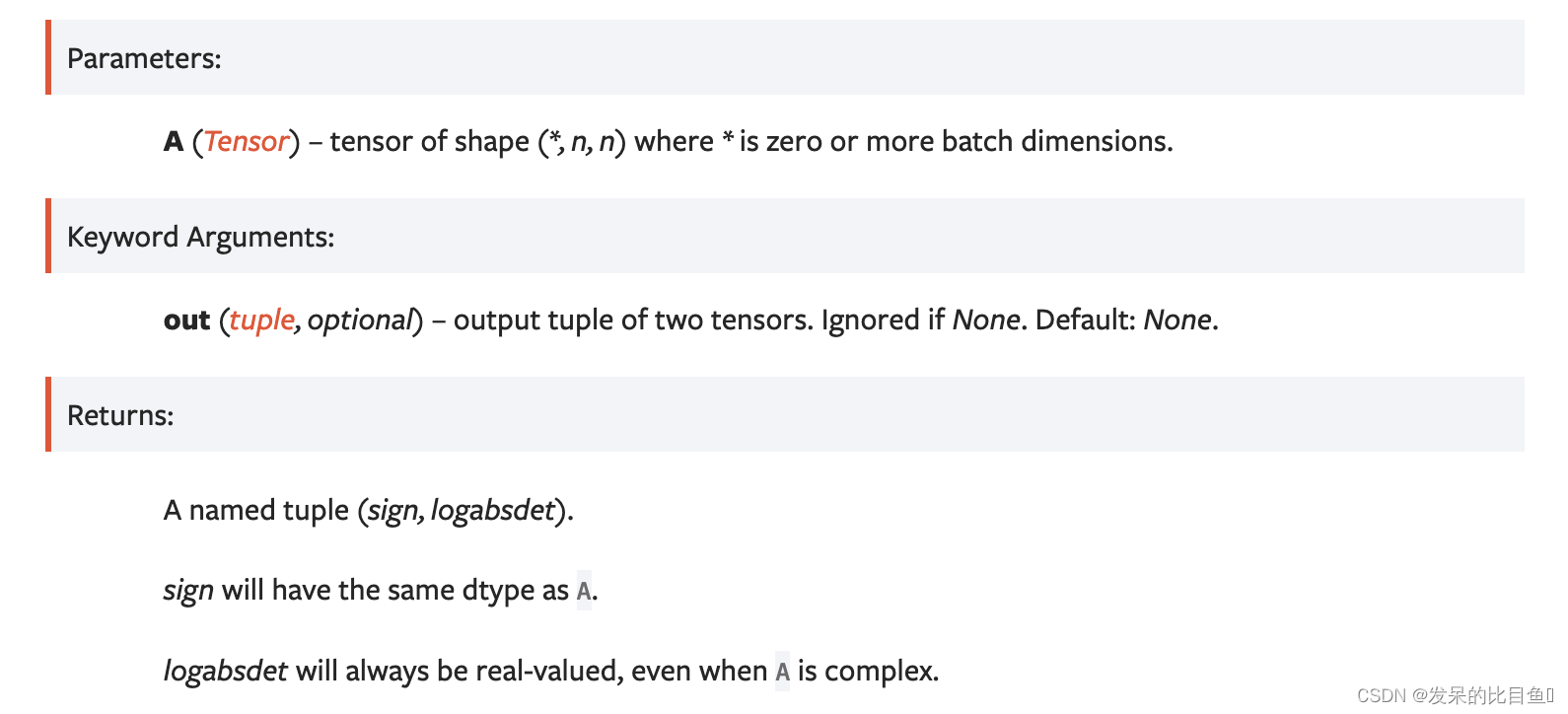
>>> A = torch.randn(3, 3)
>>> A
tensor([[ 0.0032, -0.2239, -1.1219],
[-0.6690, 0.1161, 0.4053],
[-1.6218, -0.9273, -0.0082]])
>>> torch.linalg.det(A)
tensor(-0.7576)
>>> torch.logdet(A)
tensor(nan)
>>> torch.linalg.slogdet(A)
torch.return_types.linalg_slogdet(sign=tensor(-1.), logabsdet=tensor(-0.2776))
lu
计算一个矩阵或一批矩阵A的LU因子分解。返回一个包含LU因子分解和A的枢轴的元组。如果枢轴设置为True,则完成枢轴旋转。
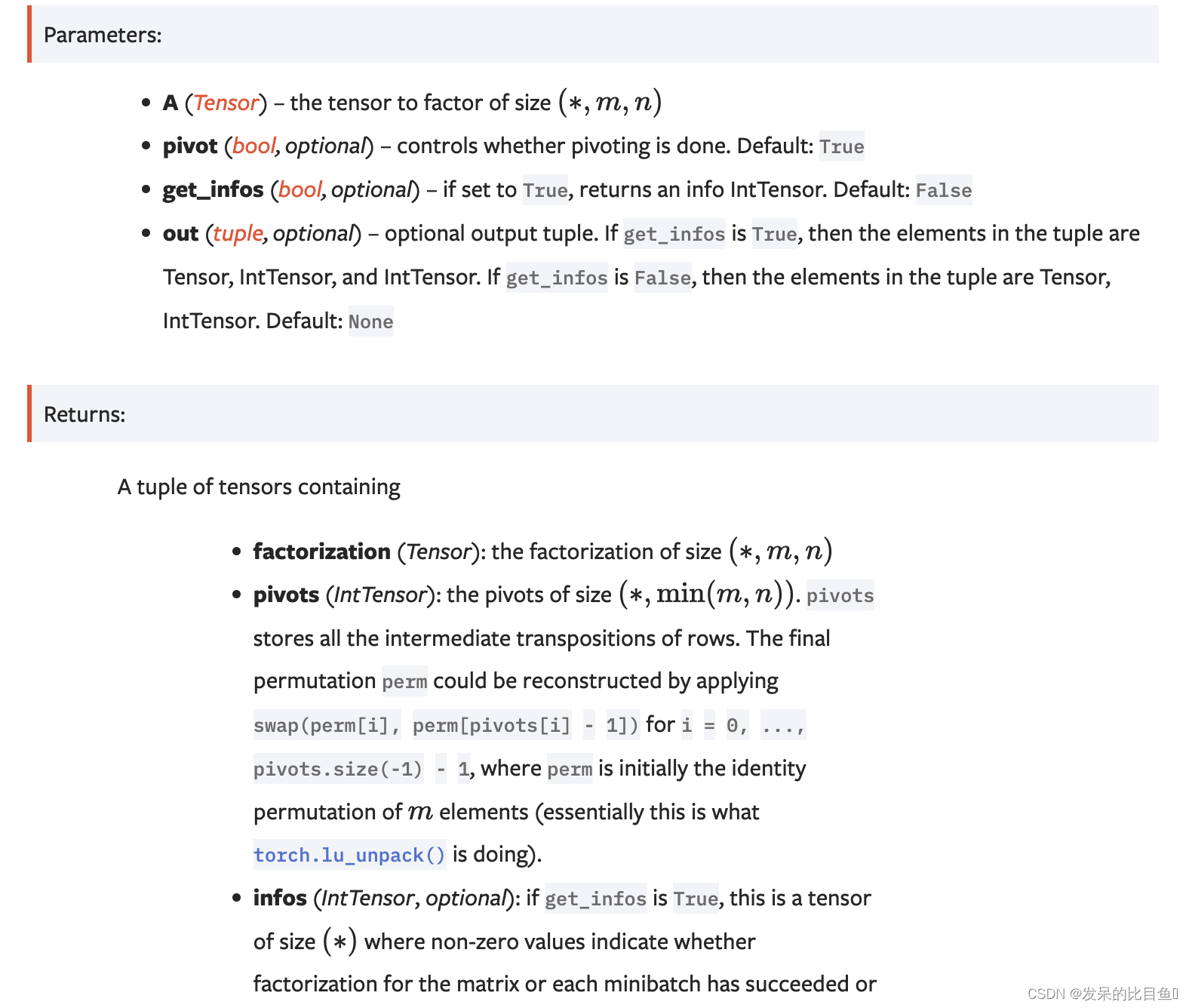
>>> A = torch.randn(2, 3, 3)
>>> A_LU, pivots = torch.lu(A)
>>> A_LU
tensor([[[ 1.3506, 2.5558, -0.0816],
[ 0.1684, 1.1551, 0.1940],
[ 0.1193, 0.6189, -0.5497]],
[[ 0.4526, 1.2526, -0.3285],
[-0.7988, 0.7175, -0.9701],
[ 0.2634, -0.9255, -0.3459]]])
>>> pivots
tensor([[ 3, 3, 3],
[ 3, 3, 3]], dtype=torch.int32)
>>> A_LU, pivots, info = torch.lu(A, get_infos=True)
>>> if info.nonzero().size(0) == 0:
... print('LU factorization succeeded for all samples!')
LU factorization succeeded for all samples!
lu_solve
使用LU_factor()中A的部分枢轴LU因子分解返回线性系统Ax=b的LU解。
此函数支持float、double、cfloat和cddouble数据类型的输入。

>>> A = torch.randn(2, 3, 3)
>>> b = torch.randn(2, 3, 1)
>>> LU, pivots = torch.linalg.lu_factor(A)
>>> x = torch.lu_solve(b, LU, pivots)
>>> torch.dist(A @ x, b)
tensor(1.00000e-07 *
2.8312)
lu_unpack
将LU_factor()返回的LU分解解压为P、L、U矩阵。

>>> A = torch.randn(2, 3, 3)
>>> LU, pivots = torch.linalg.lu_factor(A)
>>> P, L, U = torch.lu_unpack(LU, pivots)
>>> # We can recover A from the factorization
>>> A_ = P @ L @ U
>>> torch.allclose(A, A_)
True
>>> # LU factorization of a rectangular matrix:
>>> A = torch.randn(2, 3, 2)
>>> LU, pivots = torch.linalg.lu_factor(A)
>>> P, L, U = torch.lu_unpack(LU, pivots)
>>> # P, L, U are the same as returned by linalg.lu
>>> P_, L_, U_ = torch.linalg.lu(A)
>>> torch.allclose(P, P_) and torch.allclose(L, L_) and torch.allclose(U, U_)
True
matmul
两个张量的矩阵乘积。

>>> # vector x vector
>>> tensor1 = torch.randn(3)
>>> tensor2 = torch.randn(3)
>>> torch.matmul(tensor1, tensor2).size()
torch.Size([])
>>> # matrix x vector
>>> tensor1 = torch.randn(3, 4)
>>> tensor2 = torch.randn(4)
>>> torch.matmul(tensor1, tensor2).size()
torch.Size([3])
>>> # batched matrix x broadcasted vector
>>> tensor1 = torch.randn(10, 3, 4)
>>> tensor2 = torch.randn(4)
>>> torch.matmul(tensor1, tensor2).size()
torch.Size([10, 3])
>>> # batched matrix x batched matrix
>>> tensor1 = torch.randn(10, 3, 4)
>>> tensor2 = torch.randn(10, 4, 5)
>>> torch.matmul(tensor1, tensor2).size()
torch.Size([10, 3, 5])
>>> # batched matrix x broadcasted matrix
>>> tensor1 = torch.randn(10, 3, 4)
>>> tensor2 = torch.randn(4, 5)
>>> torch.matmul(tensor1, tensor2).size()
torch.Size([10, 3, 5])
matrix_power
计算整数n的平方矩阵的n次方。

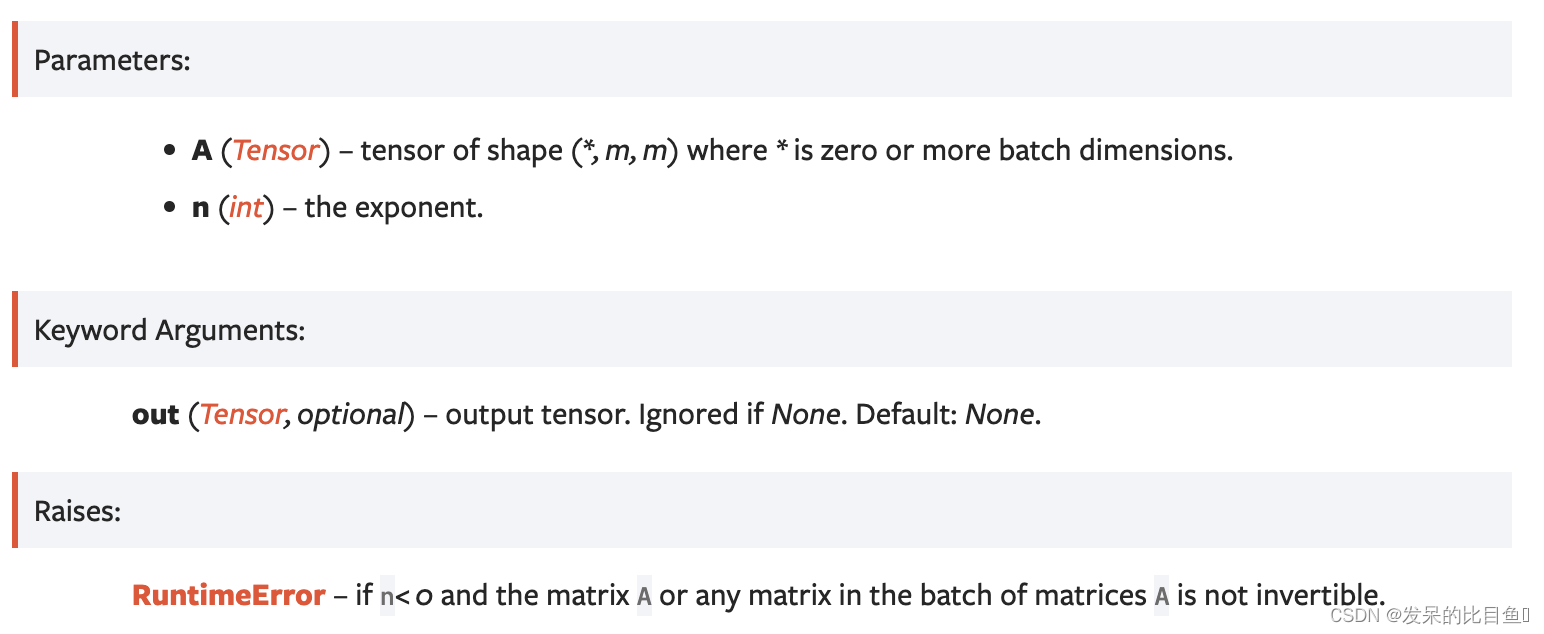
>>> A = torch.randn(3, 3)
>>> torch.linalg.matrix_power(A, 0)
tensor([[1., 0., 0.],
[0., 1., 0.],
[0., 0., 1.]])
>>> torch.linalg.matrix_power(A, 3)
tensor([[ 1.0756, 0.4980, 0.0100],
[-1.6617, 1.4994, -1.9980],
[-0.4509, 0.2731, 0.8001]])
>>> torch.linalg.matrix_power(A.expand(2, -1, -1), -2)
tensor([[[ 0.2640, 0.4571, -0.5511],
[-1.0163, 0.3491, -1.5292],
[-0.4899, 0.0822, 0.2773]],
[[ 0.2640, 0.4571, -0.5511],
[-1.0163, 0.3491, -1.5292],
[-0.4899, 0.0822, 0.2773]]])
matrix_exp
计算平方矩阵的指数矩阵。

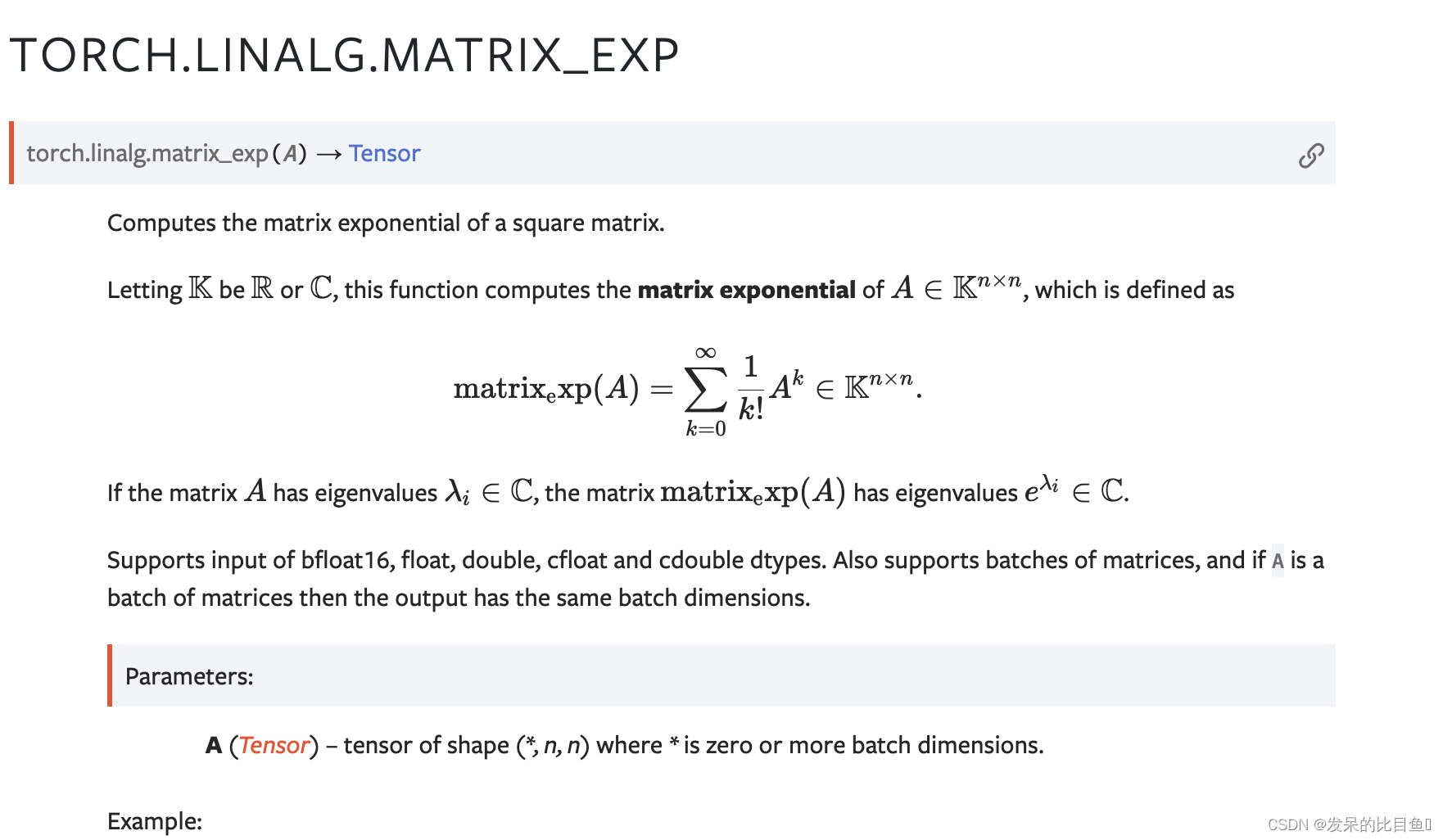
mm
对矩阵输入和mat2执行矩阵乘法运算。
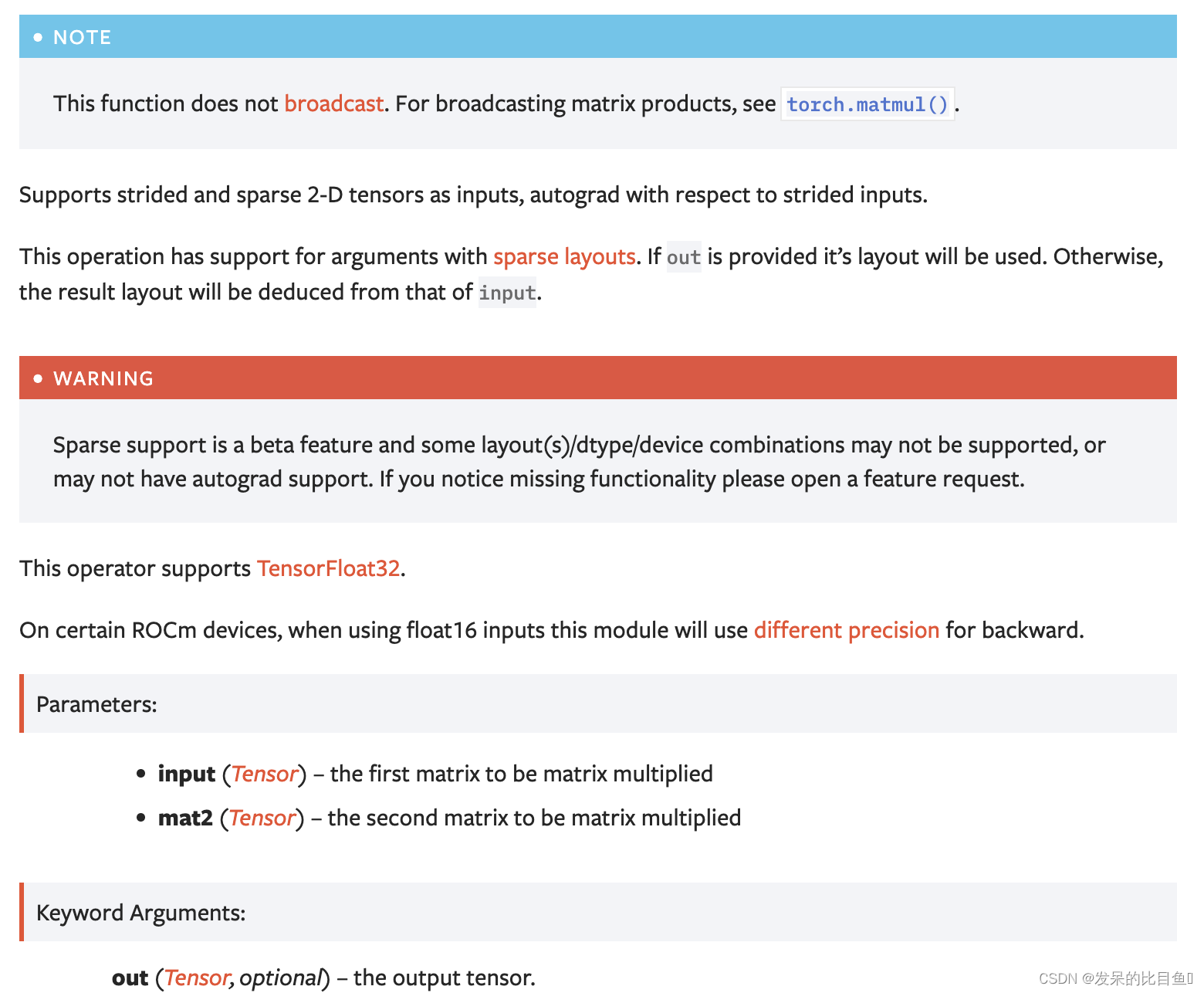
>>> mat1 = torch.randn(2, 3)
>>> mat2 = torch.randn(3, 3)
>>> torch.mm(mat1, mat2)
tensor([[ 0.4851, 0.5037, -0.3633],
[-0.0760, -3.6705, 2.4784]])
mv
执行矩阵输入和向量vec的矩阵向量乘积。
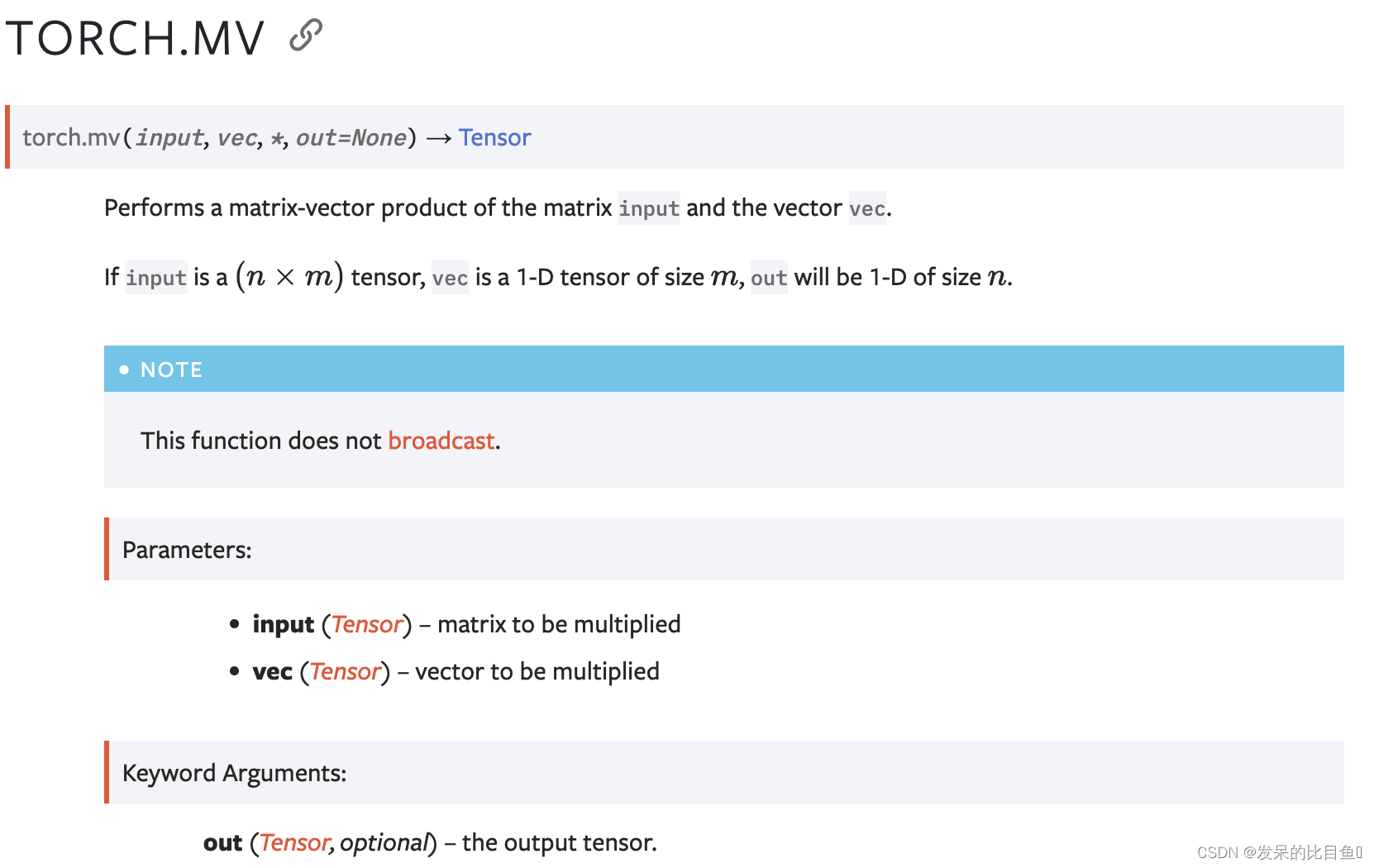
>>> mat = torch.randn(2, 3)
>>> vec = torch.randn(3)
>>> torch.mv(mat, vec)
tensor([ 1.0404, -0.6361])
orgqr
torch.linear.householder_product()的别名。
计算Householder矩阵乘积的前n列。
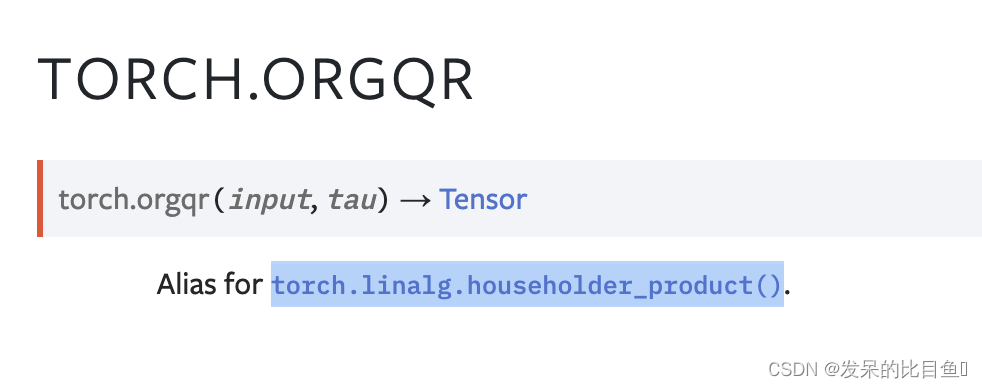
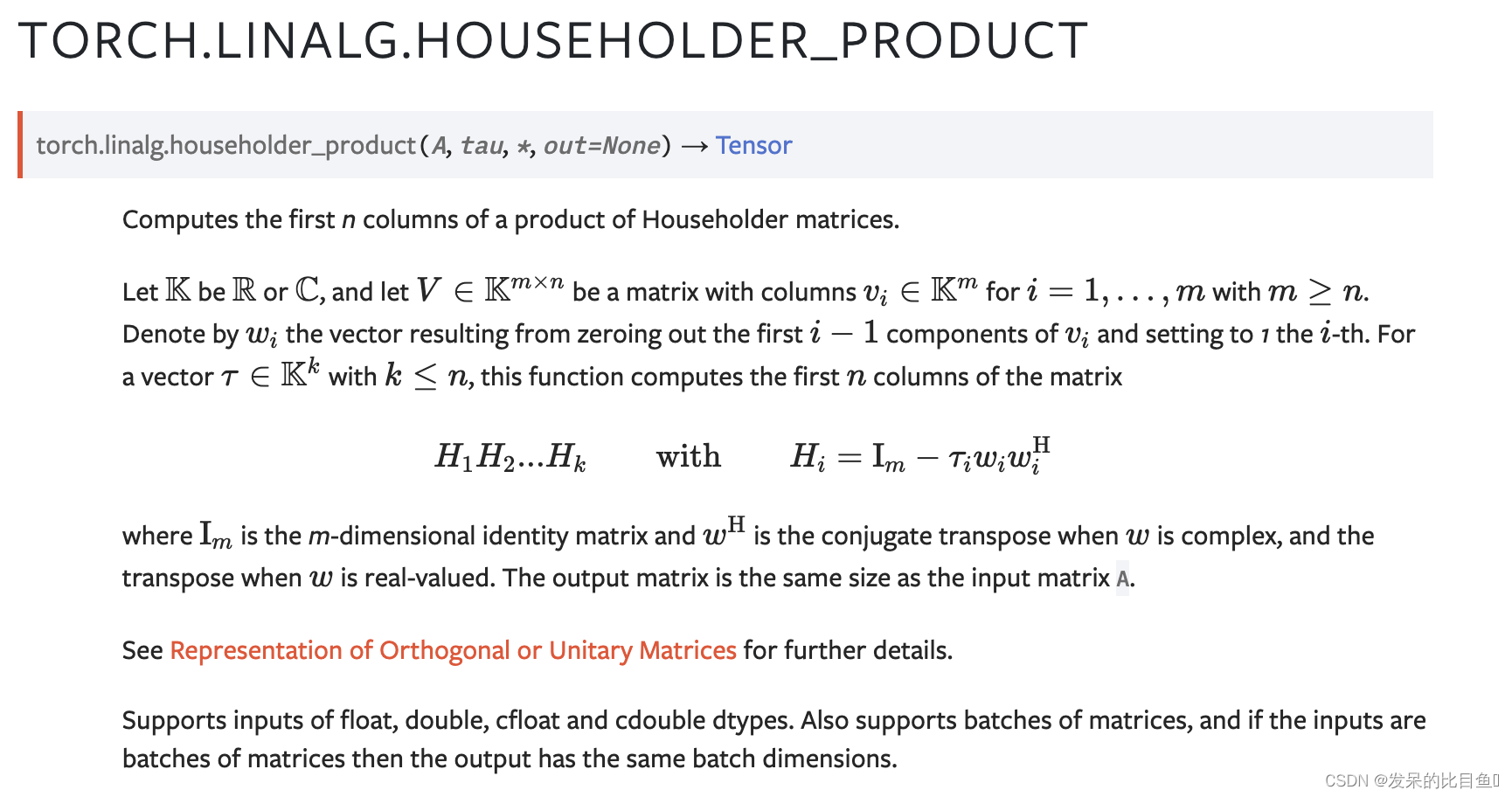
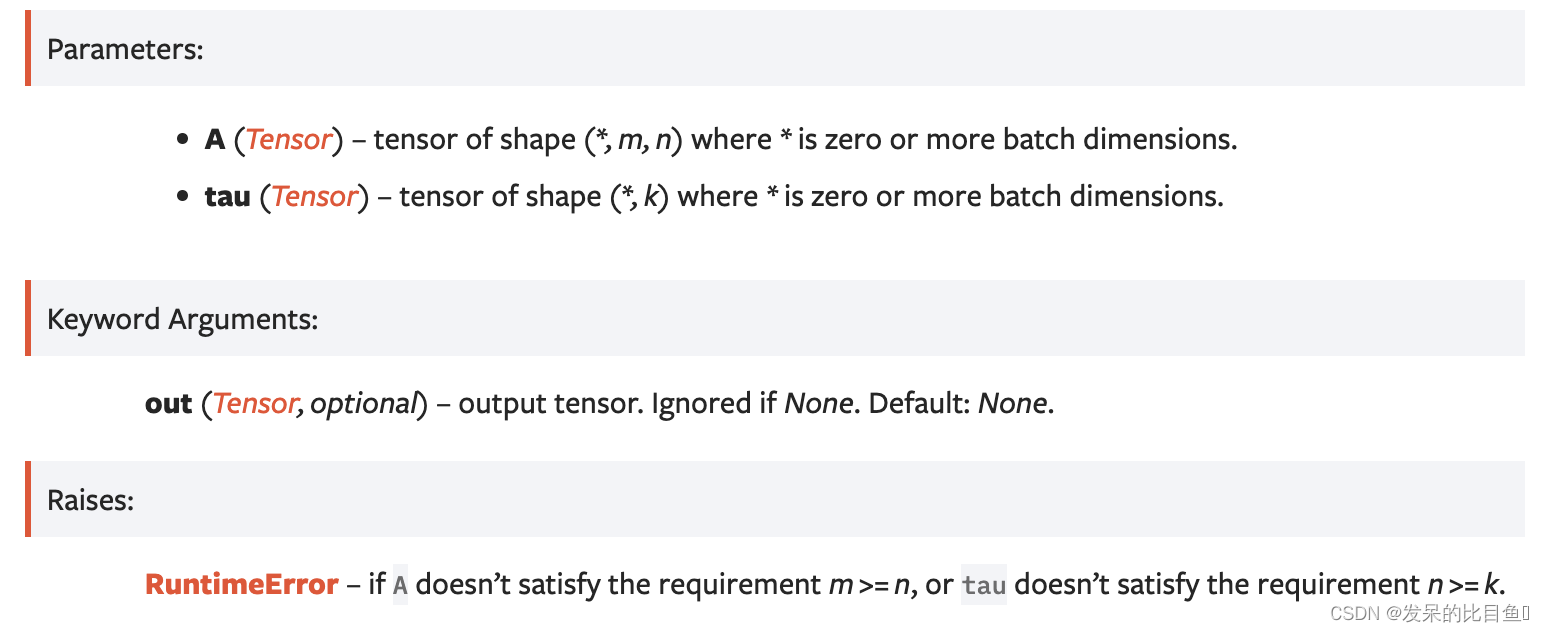
>>> A = torch.randn(2, 2)
>>> h, tau = torch.geqrf(A)
>>> Q = torch.linalg.householder_product(h, tau)
>>> torch.dist(Q, torch.linalg.qr(A).Q)
tensor(0.)
>>> h = torch.randn(3, 2, 2, dtype=torch.complex128)
>>> tau = torch.randn(3, 1, dtype=torch.complex128)
>>> Q = torch.linalg.householder_product(h, tau)
>>> Q
tensor([[[ 1.8034+0.4184j, 0.2588-1.0174j],
[-0.6853+0.7953j, 2.0790+0.5620j]],
[[ 1.4581+1.6989j, -1.5360+0.1193j],
[ 1.3877-0.6691j, 1.3512+1.3024j]],
[[ 1.4766+0.5783j, 0.0361+0.6587j],
[ 0.6396+0.1612j, 1.3693+0.4481j]]], dtype=torch.complex128)
ormqr
计算Householder矩阵的乘积与一般矩阵的矩阵乘积。
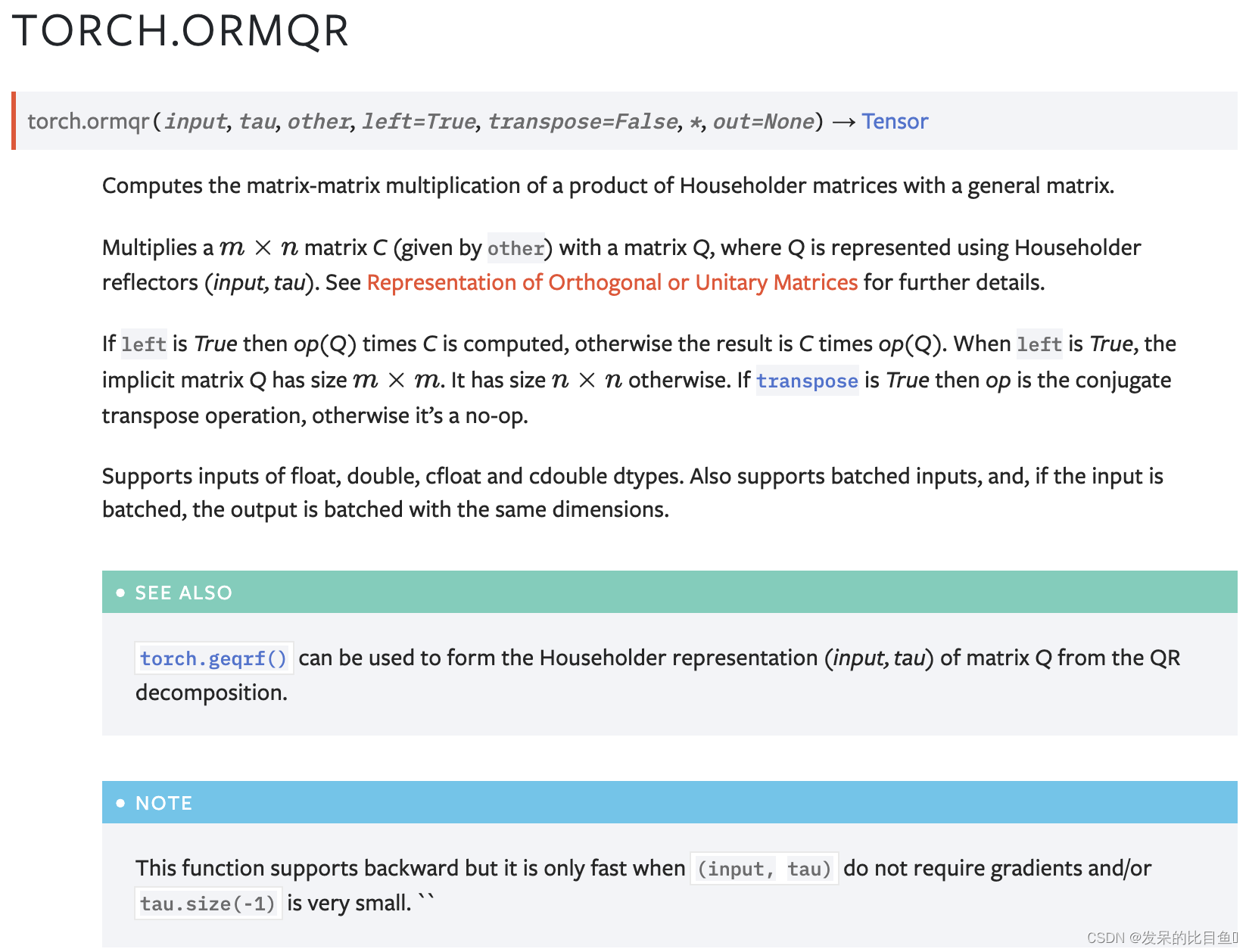

outer
输入和vec2的外积。如果input是大小为n的向量,vec2是大小为m的向量,那么out必须是大小为(n×m)的矩阵。
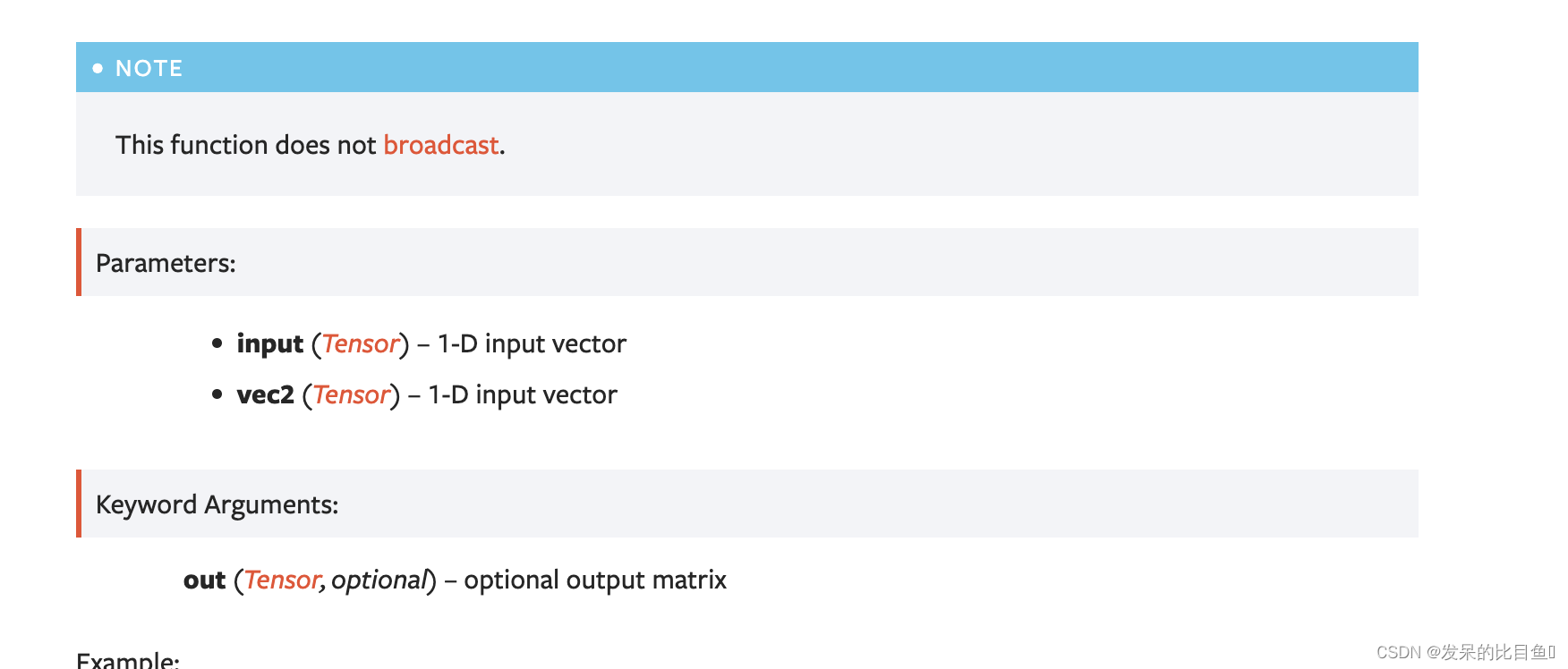
>>> v1 = torch.arange(1., 5.)
>>> v2 = torch.arange(1., 4.)
>>> torch.outer(v1, v2)
tensor([[ 1., 2., 3.],
[ 2., 4., 6.],
[ 3., 6., 9.],
[ 4., 8., 12.]])
pinverse
torch.linalg.pinv()的别名
计算一个矩阵的伪逆(摩尔-彭罗斯逆)。

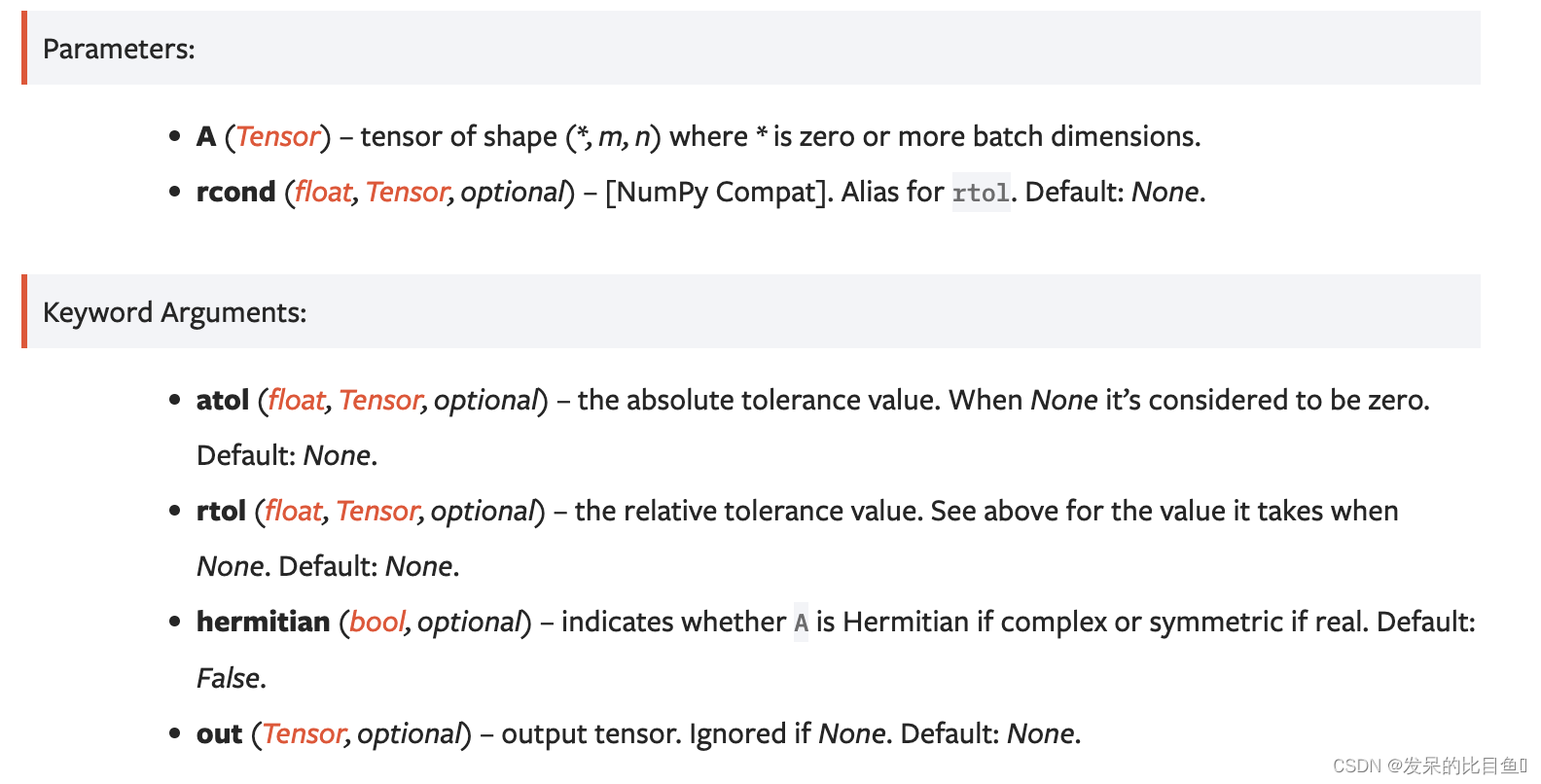
>>> A = torch.randn(3, 5)
>>> A
tensor([[ 0.5495, 0.0979, -1.4092, -0.1128, 0.4132],
[-1.1143, -0.3662, 0.3042, 1.6374, -0.9294],
[-0.3269, -0.5745, -0.0382, -0.5922, -0.6759]])
>>> torch.linalg.pinv(A)
tensor([[ 0.0600, -0.1933, -0.2090],
[-0.0903, -0.0817, -0.4752],
[-0.7124, -0.1631, -0.2272],
[ 0.1356, 0.3933, -0.5023],
[-0.0308, -0.1725, -0.5216]])
>>> A = torch.randn(2, 6, 3)
>>> Apinv = torch.linalg.pinv(A)
>>> torch.dist(Apinv @ A, torch.eye(3))
tensor(8.5633e-07)
>>> A = torch.randn(3, 3, dtype=torch.complex64)
>>> A = A + A.T.conj() # creates a Hermitian matrix
>>> Apinv = torch.linalg.pinv(A, hermitian=True)
>>> torch.dist(Apinv @ A, torch.eye(3))
tensor(1.0830e-06)
qr
计算输入的一个矩阵或一批矩阵的QR分解,并返回张量的命名元组(Q,R),使得input=QR,其中Q是正交矩阵或一组正交矩阵,R是上三角矩阵或上三角矩阵。

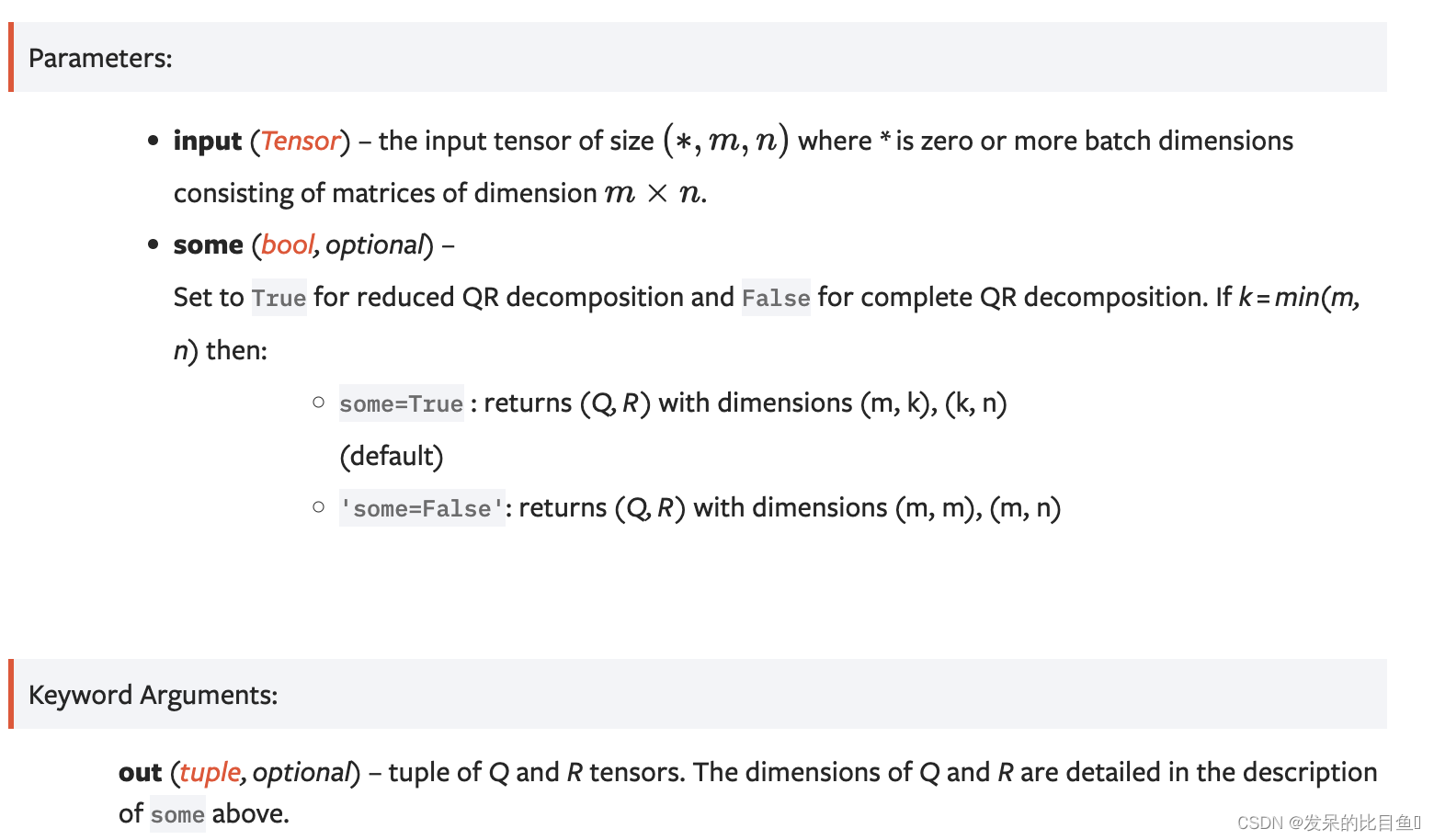
>>> a = torch.tensor([[12., -51, 4], [6, 167, -68], [-4, 24, -41]])
>>> q, r = torch.qr(a)
>>> q
tensor([[-0.8571, 0.3943, 0.3314],
[-0.4286, -0.9029, -0.0343],
[ 0.2857, -0.1714, 0.9429]])
>>> r
tensor([[ -14.0000, -21.0000, 14.0000],
[ 0.0000, -175.0000, 70.0000],
[ 0.0000, 0.0000, -35.0000]])
>>> torch.mm(q, r).round()
tensor([[ 12., -51., 4.],
[ 6., 167., -68.],
[ -4., 24., -41.]])
>>> torch.mm(q.t(), q).round()
tensor([[ 1., 0., 0.],
[ 0., 1., -0.],
[ 0., -0., 1.]])
>>> a = torch.randn(3, 4, 5)
>>> q, r = torch.qr(a, some=False)
>>> torch.allclose(torch.matmul(q, r), a)
True
>>> torch.allclose(torch.matmul(q.mT, q), torch.eye(5))
True
svd
计算一个矩阵或一批矩阵输入的奇异值分解。奇异值分解表示为命名元组(U,S,V),使得输入=U diag(S)VH。其中VH是实数输入的V的转置,以及复数输入的V共轭转置。如果输入是一批矩阵,那么U、S和V也以与输入相同的批维度进行批处理。
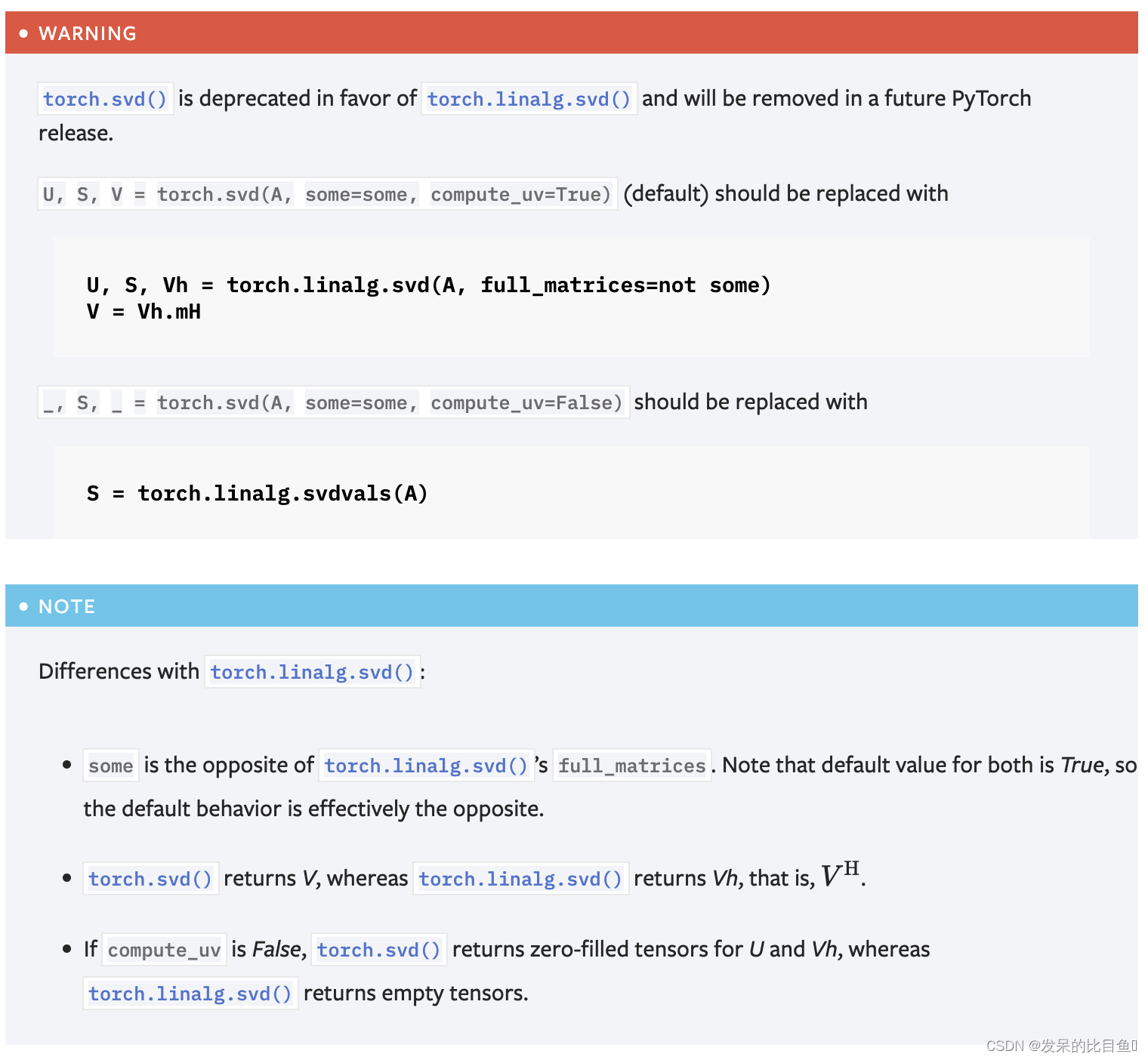
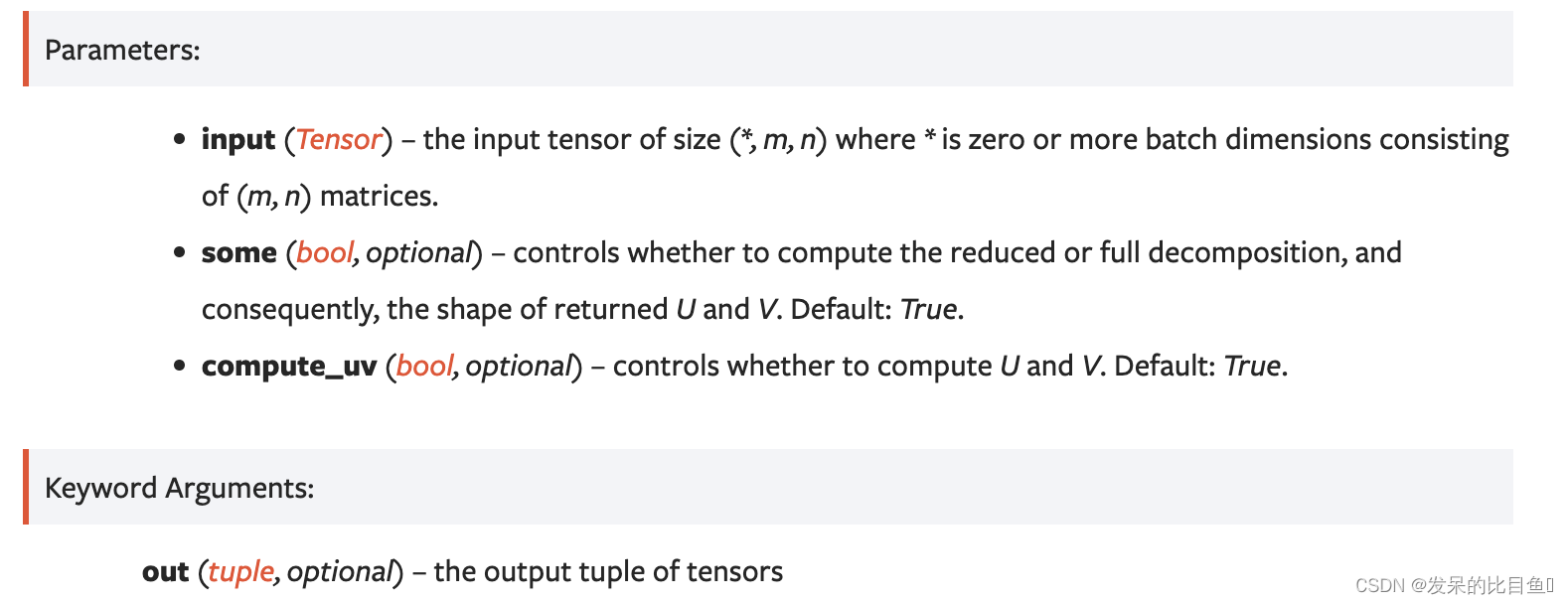
>>> a = torch.randn(5, 3)
>>> a
tensor([[ 0.2364, -0.7752, 0.6372],
[ 1.7201, 0.7394, -0.0504],
[-0.3371, -1.0584, 0.5296],
[ 0.3550, -0.4022, 1.5569],
[ 0.2445, -0.0158, 1.1414]])
>>> u, s, v = torch.svd(a)
>>> u
tensor([[ 0.4027, 0.0287, 0.5434],
[-0.1946, 0.8833, 0.3679],
[ 0.4296, -0.2890, 0.5261],
[ 0.6604, 0.2717, -0.2618],
[ 0.4234, 0.2481, -0.4733]])
>>> s
tensor([2.3289, 2.0315, 0.7806])
>>> v
tensor([[-0.0199, 0.8766, 0.4809],
[-0.5080, 0.4054, -0.7600],
[ 0.8611, 0.2594, -0.4373]])
>>> torch.dist(a, torch.mm(torch.mm(u, torch.diag(s)), v.t()))
tensor(8.6531e-07)
>>> a_big = torch.randn(7, 5, 3)
>>> u, s, v = torch.svd(a_big)
>>> torch.dist(a_big, torch.matmul(torch.matmul(u, torch.diag_embed(s)), v.mT))
tensor(2.6503e-06)
svd_lowrank
返回矩阵、矩阵批或稀疏矩阵A的奇异值分解(U, S, V),使
A
≈
U
d
i
a
g
(
S
)
V
T
A≈Udiag(S)V^T
A≈Udiag(S)VT。在给定M的情况下,则计算矩阵A−M的SVD。
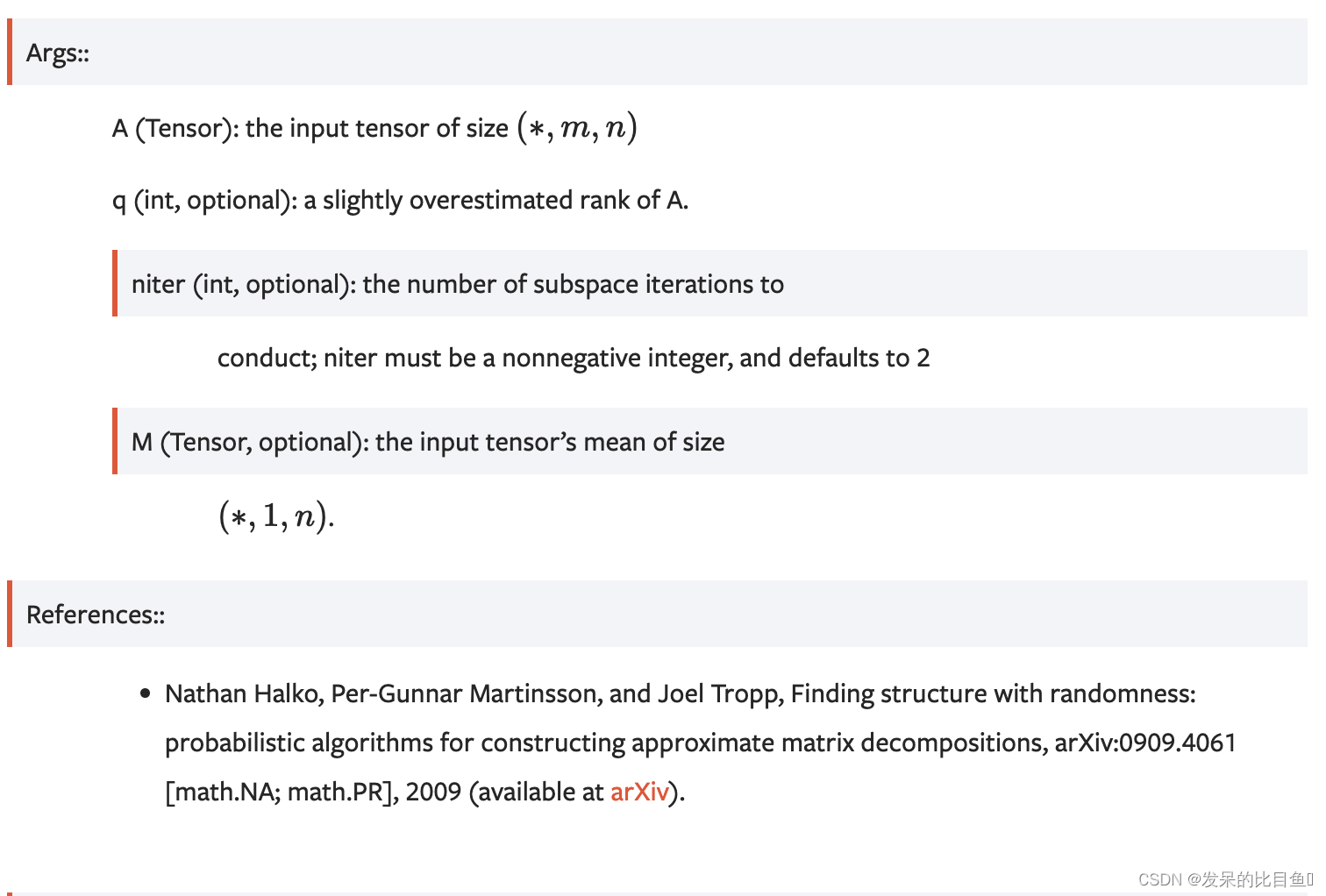
pca_lowrank
对低秩矩阵、此类矩阵的批或稀疏矩阵执行线性主成分分析(PCA)。
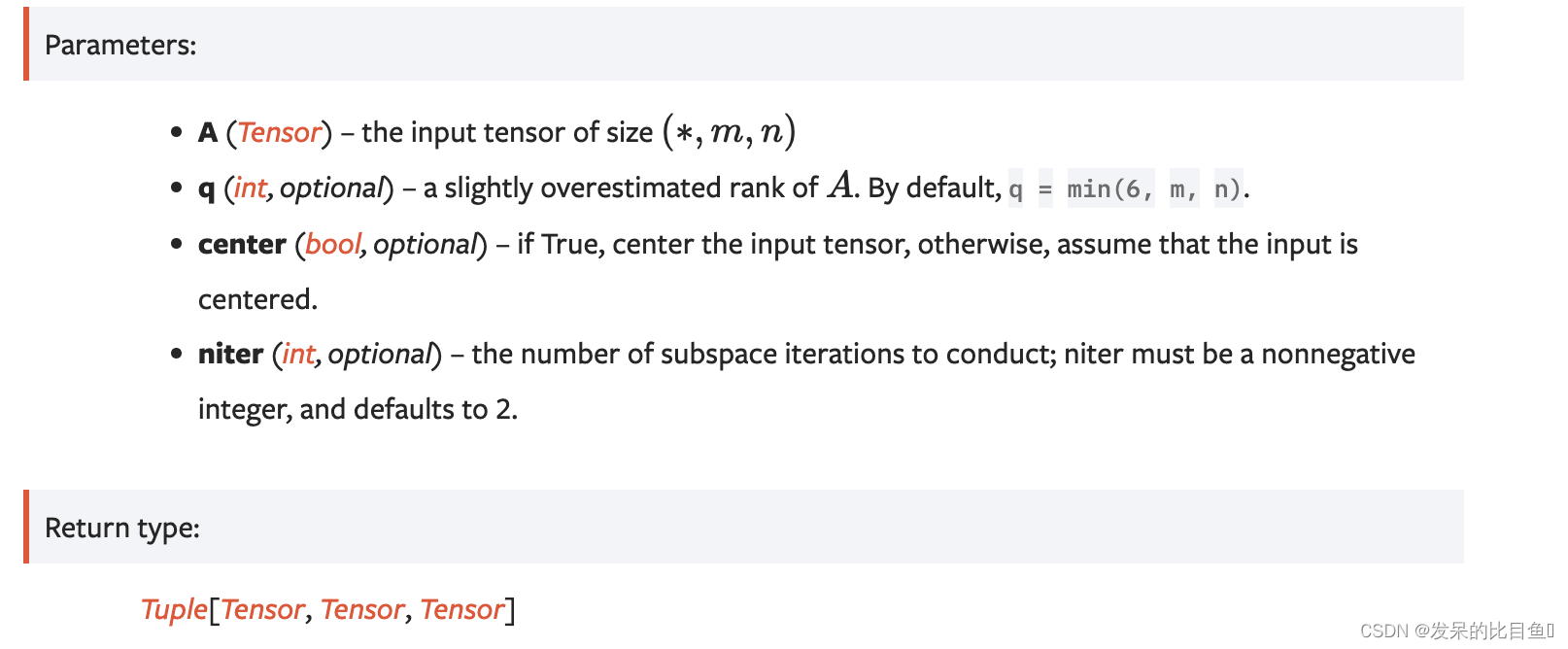
lobpcg
使用无矩阵LOBPCG方法找到对称正定广义特征值问题的k个最大(或最小)特征值和相应的特征向量。
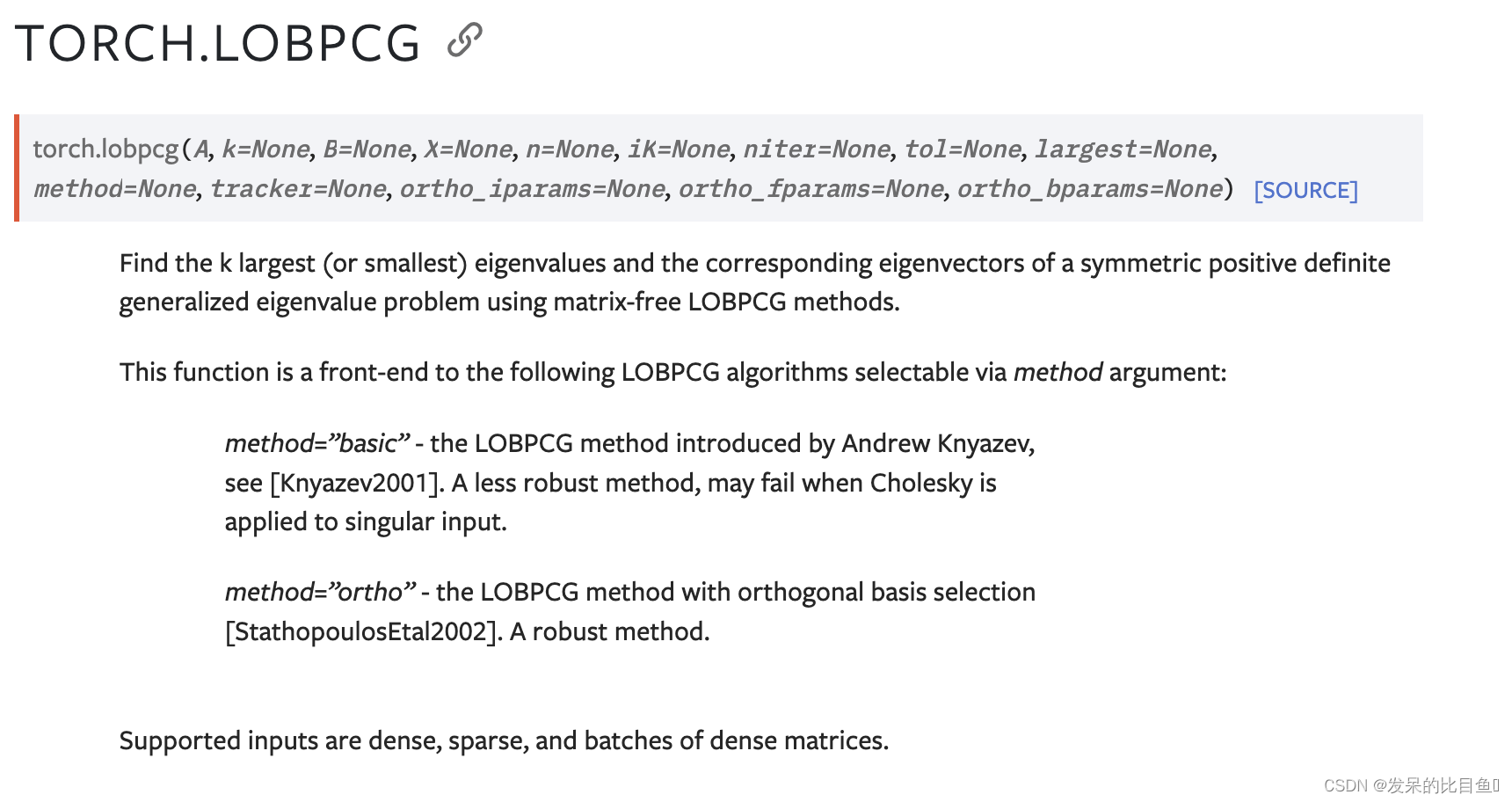
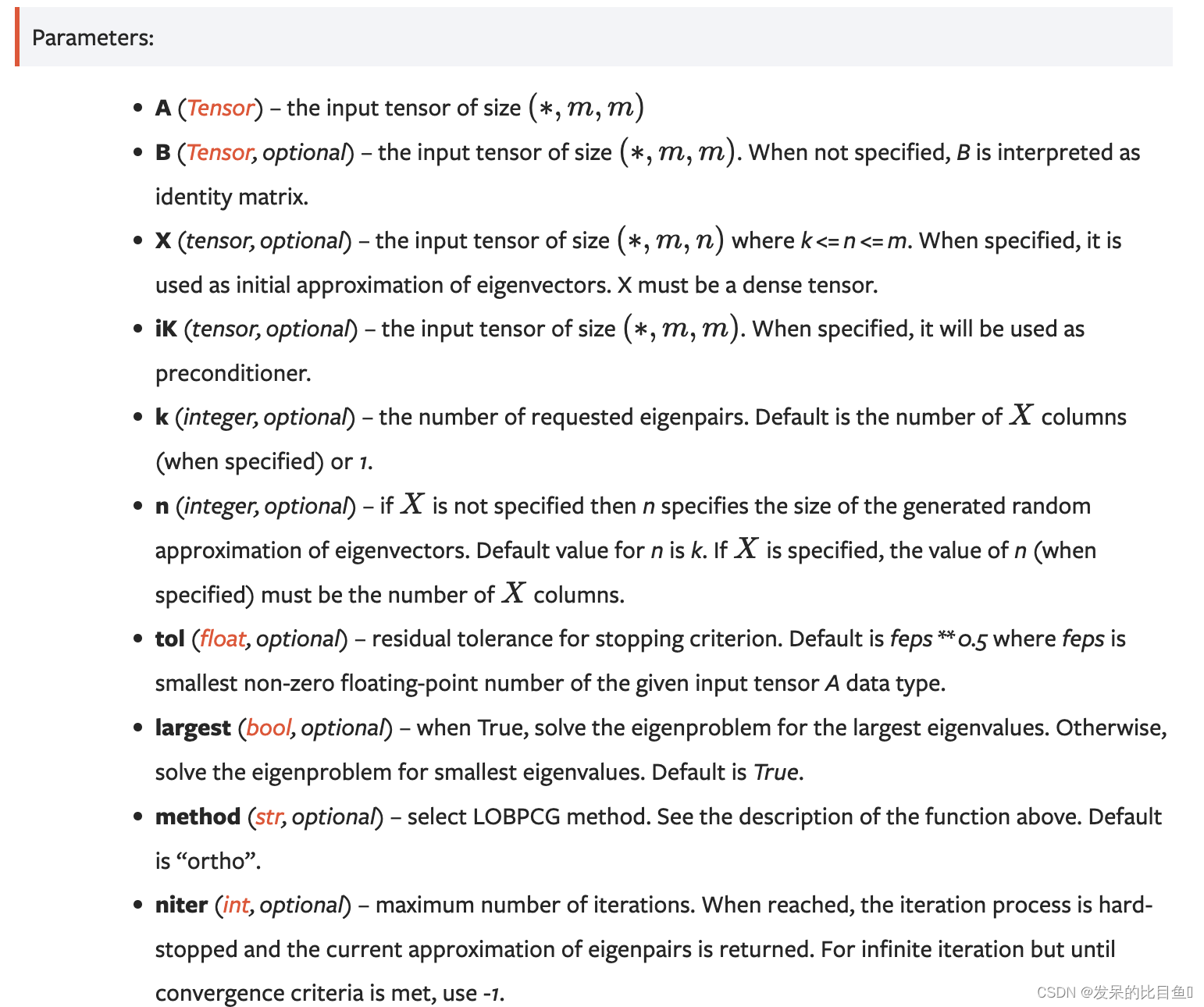
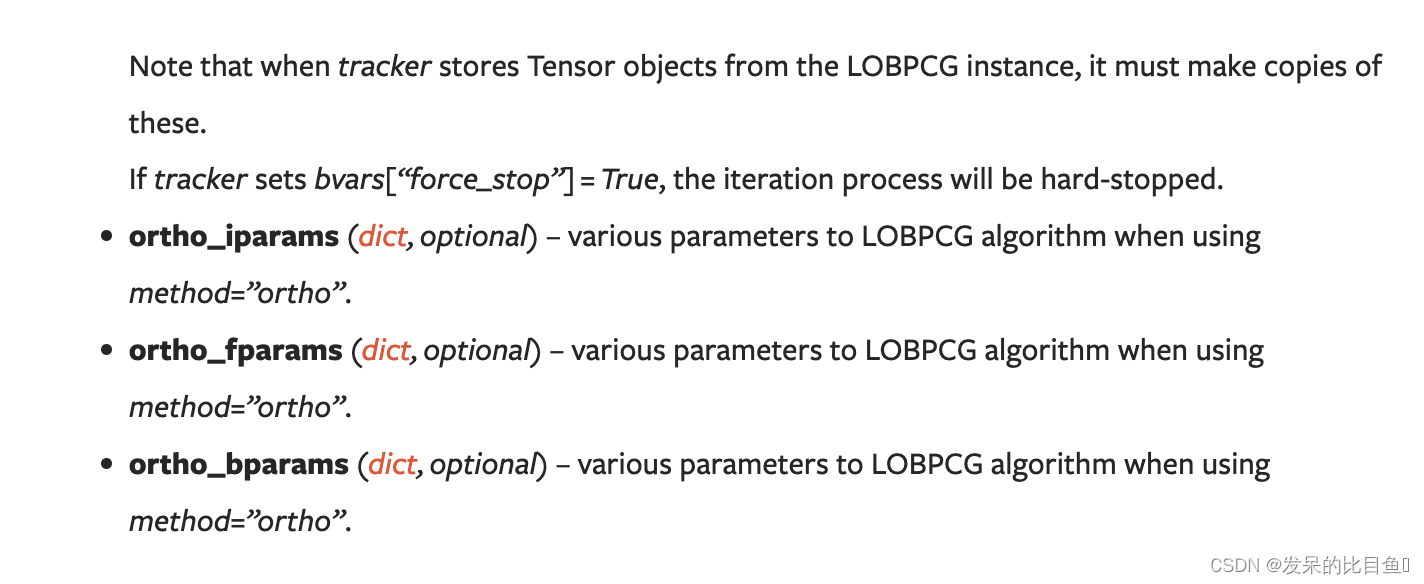
trapz
torch.trapezoid().别名
沿dim计算梯形规则。默认情况下,假设元素之间的间距为1,但dx可用于指定不同的恒定间距,x可用于指定沿dim的任意间距。
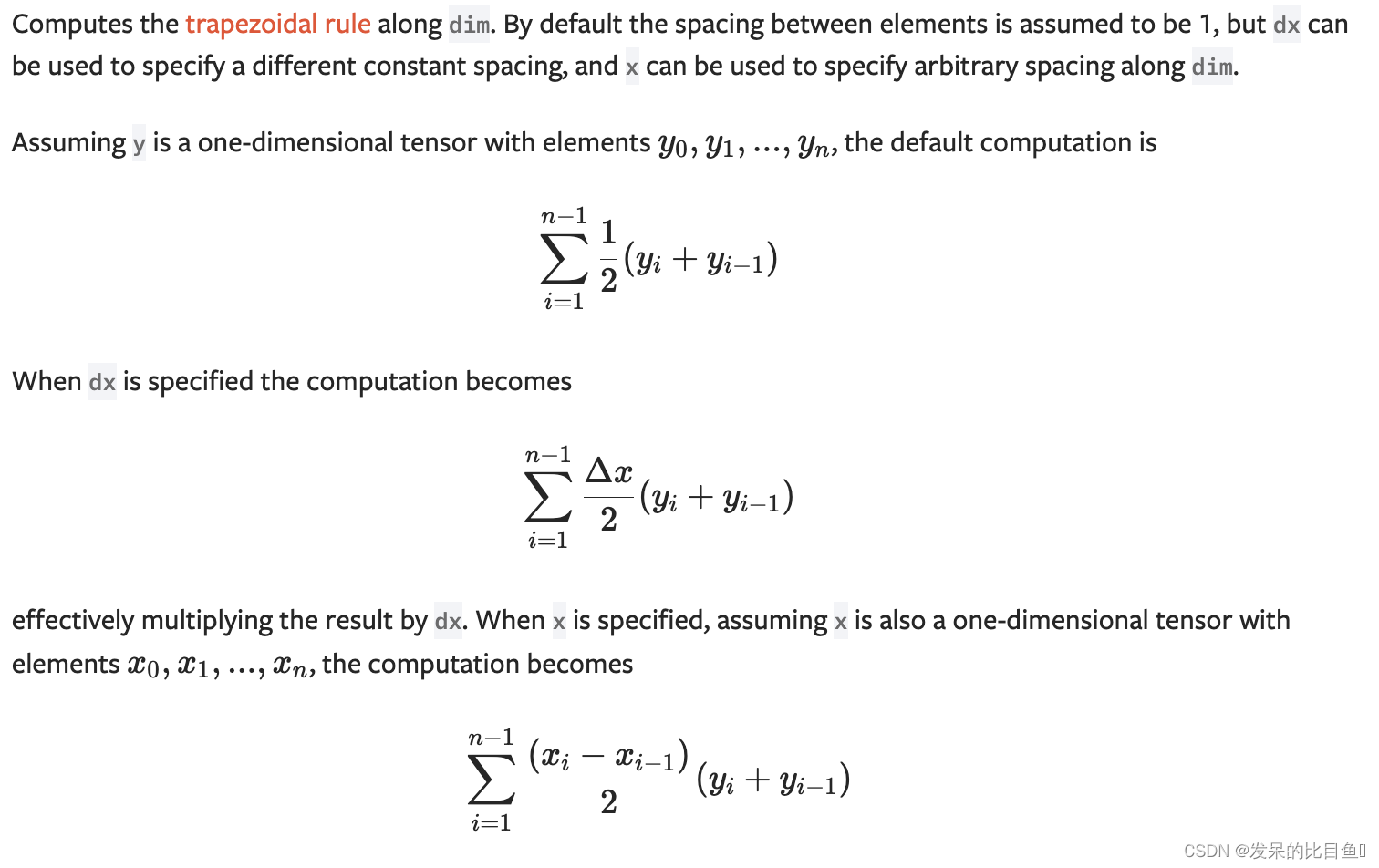
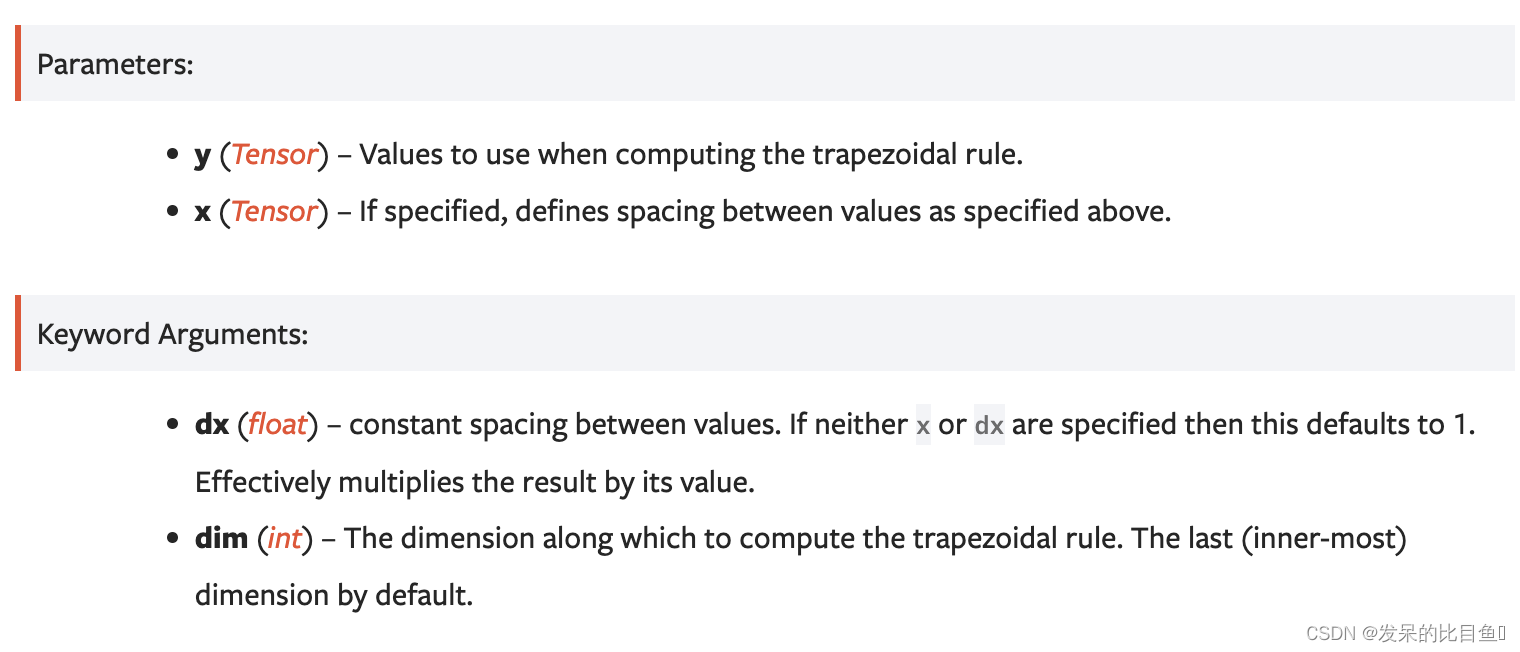
trapezoid
沿dim计算梯形规则。默认情况下,假设元素之间的间距为1,但dx可用于指定不同的恒定间距,x可用于指定沿dim的任意间距。

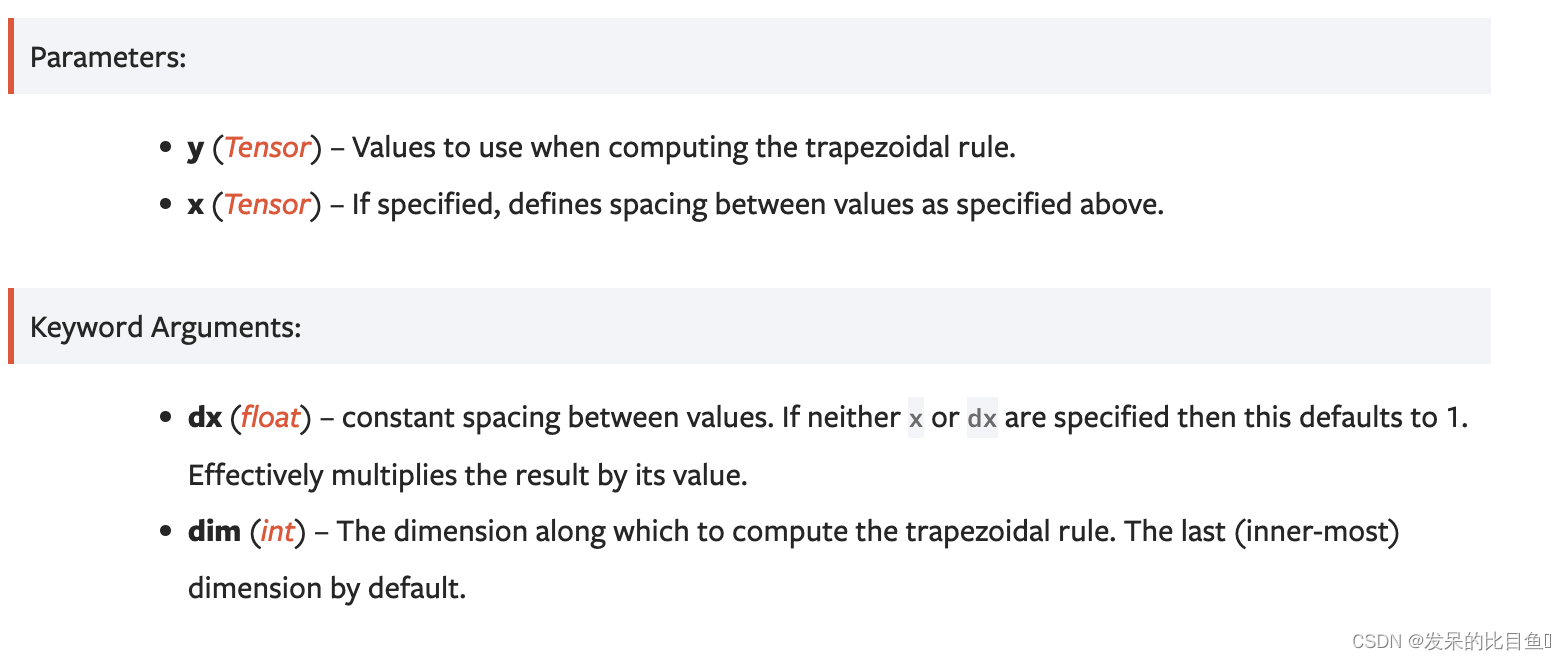
>>> # Computes the trapezoidal rule in 1D, spacing is implicitly 1
>>> y = torch.tensor([1, 5, 10])
>>> torch.trapezoid(y)
tensor(10.5)
>>> # Computes the same trapezoidal rule directly to verify
>>> (1 + 10 + 10) / 2
10.5
>>> # Computes the trapezoidal rule in 1D with constant spacing of 2
>>> # NOTE: the result is the same as before, but multiplied by 2
>>> torch.trapezoid(y, dx=2)
21.0
>>> # Computes the trapezoidal rule in 1D with arbitrary spacing
>>> x = torch.tensor([1, 3, 6])
>>> torch.trapezoid(y, x)
28.5
>>> # Computes the same trapezoidal rule directly to verify
>>> ((3 - 1) * (1 + 5) + (6 - 3) * (5 + 10)) / 2
28.5
>>> # Computes the trapezoidal rule for each row of a 3x3 matrix
>>> y = torch.arange(9).reshape(3, 3)
tensor([[0, 1, 2],
[3, 4, 5],
[6, 7, 8]])
>>> torch.trapezoid(y)
tensor([ 2., 8., 14.])
>>> # Computes the trapezoidal rule for each column of the matrix
>>> torch.trapezoid(y, dim=0)
tensor([ 6., 8., 10.])
>>> # Computes the trapezoidal rule for each row of a 3x3 ones matrix
>>> # with the same arbitrary spacing
>>> y = torch.ones(3, 3)
>>> x = torch.tensor([1, 3, 6])
>>> torch.trapezoid(y, x)
array([5., 5., 5.])
>>> # Computes the trapezoidal rule for each row of a 3x3 ones matrix
>>> # with different arbitrary spacing per row
>>> y = torch.ones(3, 3)
>>> x = torch.tensor([[1, 2, 3], [1, 3, 5], [1, 4, 7]])
>>> torch.trapezoid(y, x)
array([2., 4., 6.])
cumulative_trapezoid
沿着dim累积计算梯形规则。默认情况下,假设元素之间的间距为1,但dx可用于指定不同的恒定间距,x可用于指定沿dim的任意间距。
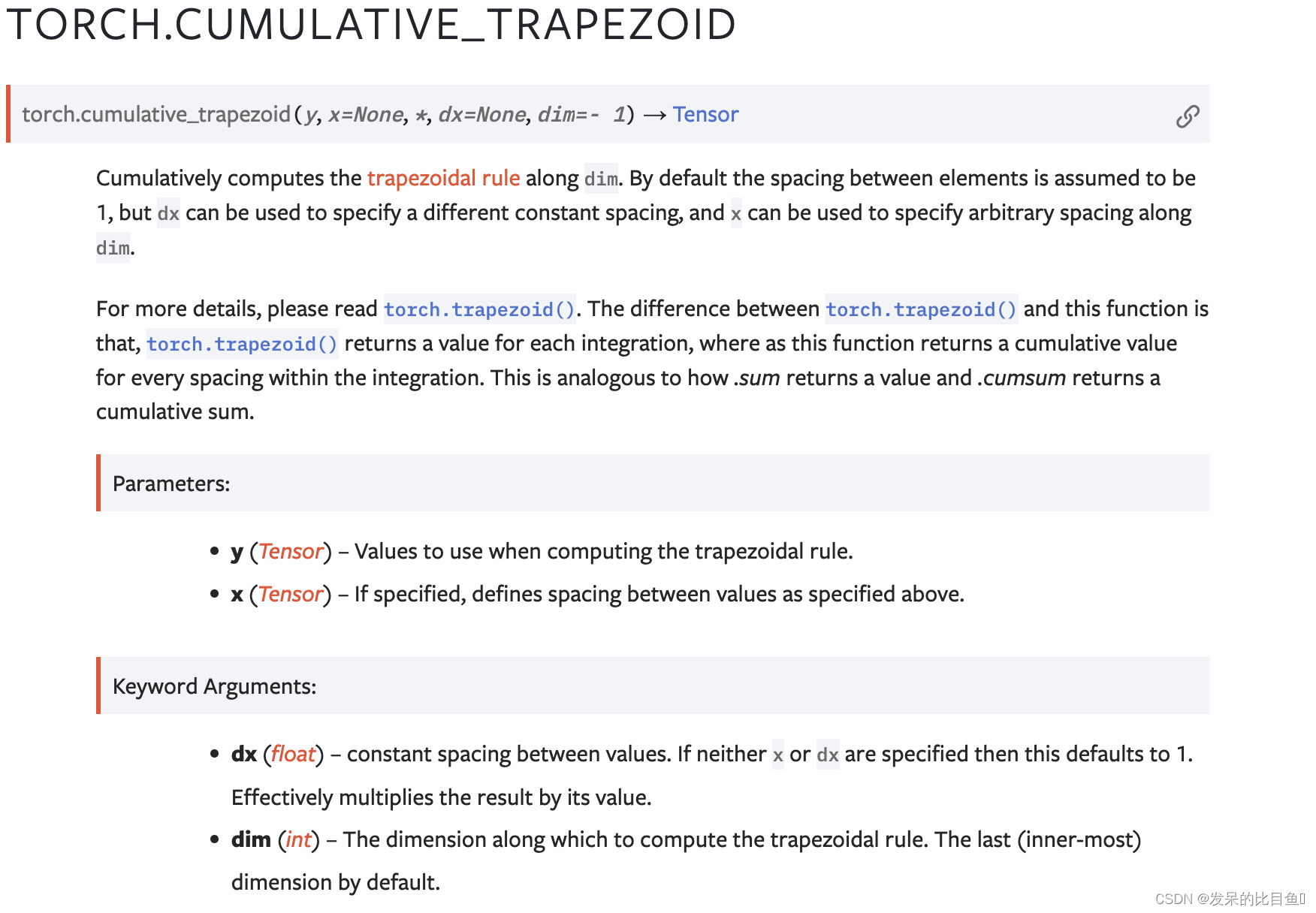
>>> # Cumulatively computes the trapezoidal rule in 1D, spacing is implicitly 1.
>>> y = torch.tensor([1, 5, 10])
>>> torch.cumulative_trapezoid(y)
tensor([3., 10.5])
>>> # Computes the same trapezoidal rule directly up to each element to verify
>>> (1 + 5) / 2
3.0
>>> (1 + 10 + 10) / 2
10.5
>>> # Cumulatively computes the trapezoidal rule in 1D with constant spacing of 2
>>> # NOTE: the result is the same as before, but multiplied by 2
>>> torch.cumulative_trapezoid(y, dx=2)
tensor([6., 21.])
>>> # Cumulatively computes the trapezoidal rule in 1D with arbitrary spacing
>>> x = torch.tensor([1, 3, 6])
>>> torch.cumulative_trapezoid(y, x)
tensor([6., 28.5])
>>> # Computes the same trapezoidal rule directly up to each element to verify
>>> ((3 - 1) * (1 + 5)) / 2
6.0
>>> ((3 - 1) * (1 + 5) + (6 - 3) * (5 + 10)) / 2
28.5
>>> # Cumulatively computes the trapezoidal rule for each row of a 3x3 matrix
>>> y = torch.arange(9).reshape(3, 3)
tensor([[0, 1, 2],
[3, 4, 5],
[6, 7, 8]])
>>> torch.cumulative_trapezoid(y)
tensor([[ 0.5, 2.],
[ 3.5, 8.],
[ 6.5, 14.]])
>>> # Cumulatively computes the trapezoidal rule for each column of the matrix
>>> torch.cumulative_trapezoid(y, dim=0)
tensor([[ 1.5, 2.5, 3.5],
[ 6.0, 8.0, 10.0]])
>>> # Cumulatively computes the trapezoidal rule for each row of a 3x3 ones matrix
>>> # with the same arbitrary spacing
>>> y = torch.ones(3, 3)
>>> x = torch.tensor([1, 3, 6])
>>> torch.cumulative_trapezoid(y, x)
tensor([[2., 5.],
[2., 5.],
[2., 5.]])
>>> # Cumulatively computes the trapezoidal rule for each row of a 3x3 ones matrix
>>> # with different arbitrary spacing per row
>>> y = torch.ones(3, 3)
>>> x = torch.tensor([[1, 2, 3], [1, 3, 5], [1, 4, 7]])
>>> torch.cumulative_trapezoid(y, x)
tensor([[1., 2.],
[2., 4.],
[3., 6.]])
triangular_solve
求解具有正方形上或下三角形可逆矩阵A和多个右手边b的方程组。
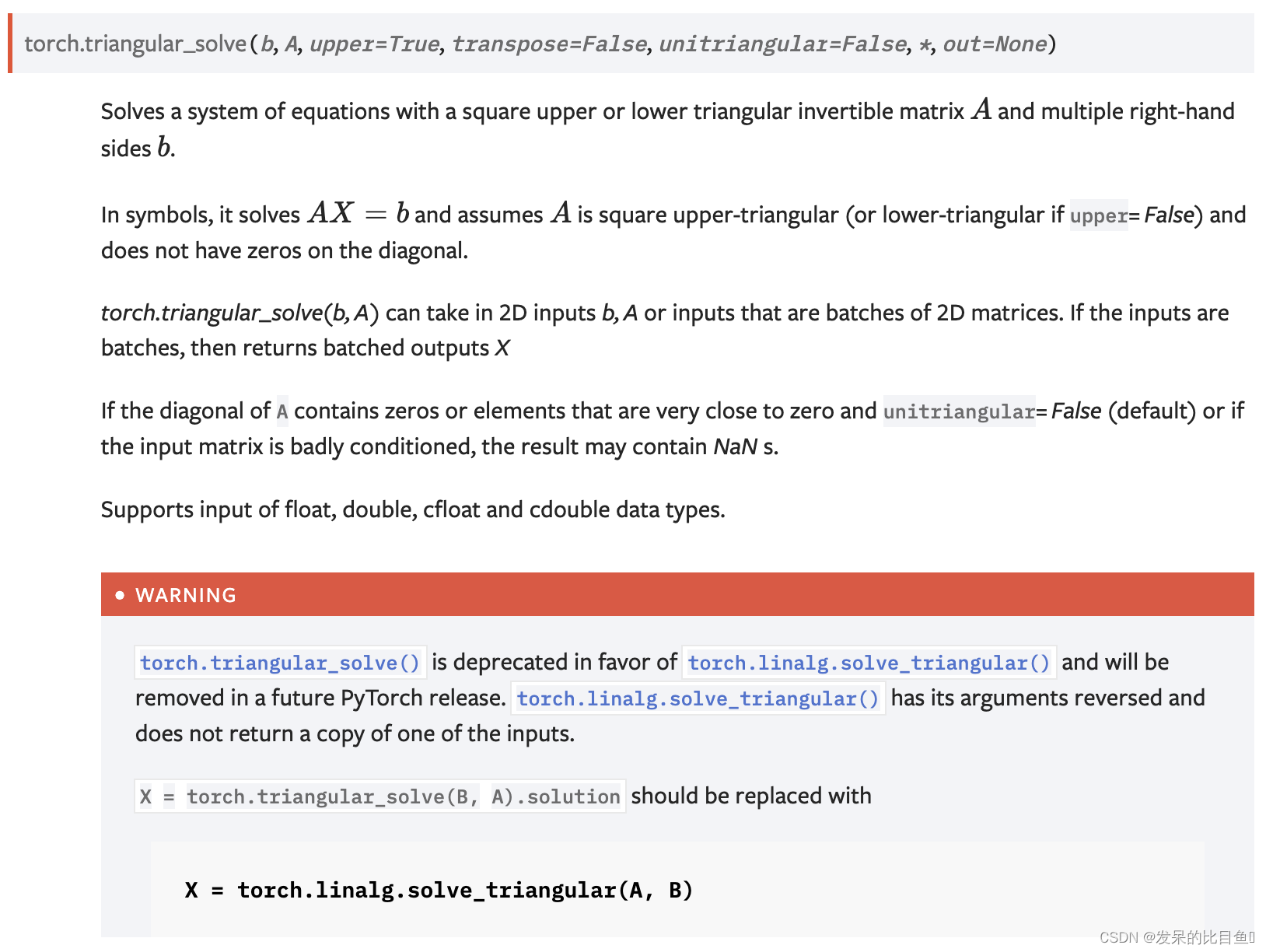
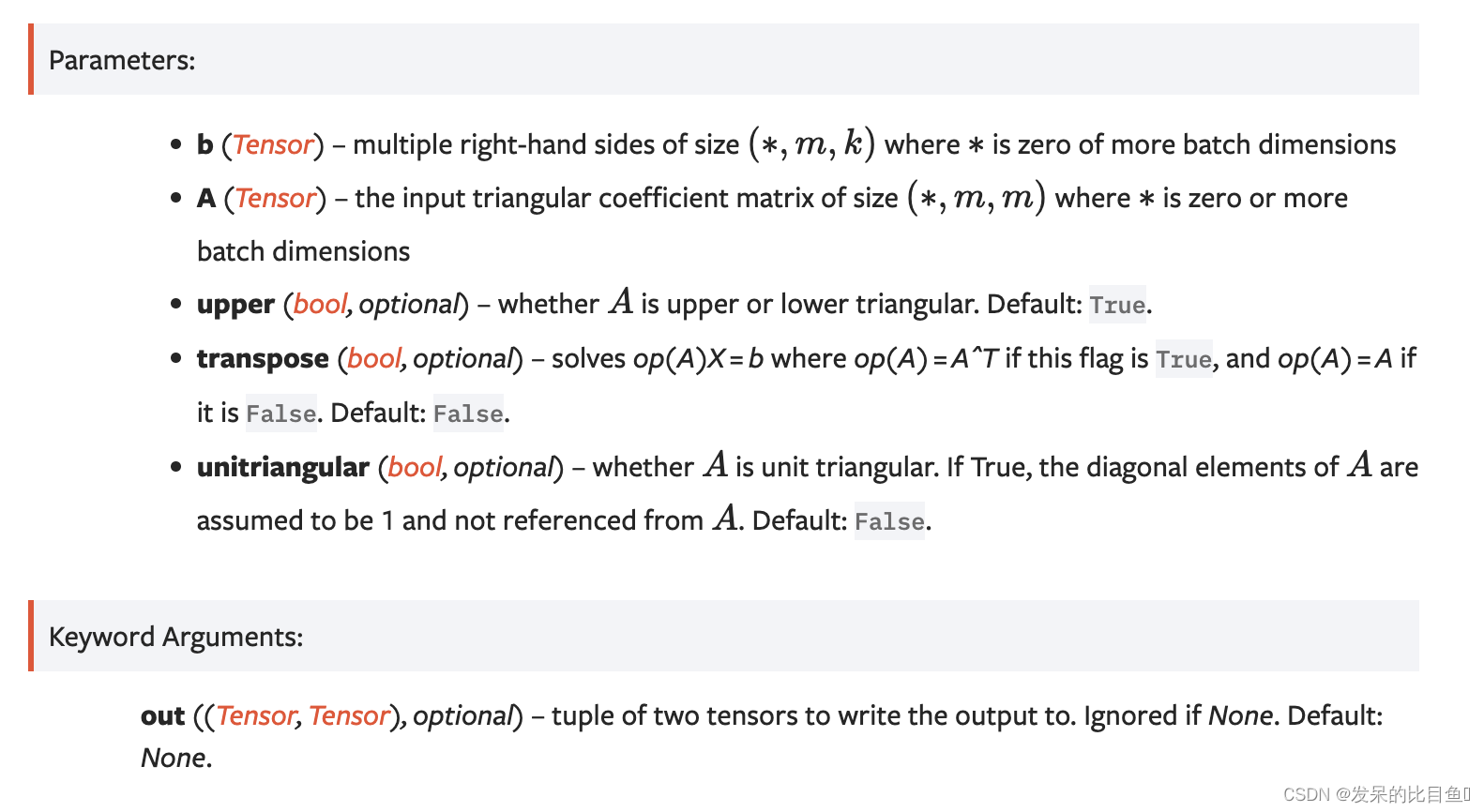
>>> A = torch.randn(2, 2).triu()
>>> A
tensor([[ 1.1527, -1.0753],
[ 0.0000, 0.7986]])
>>> b = torch.randn(2, 3)
>>> b
tensor([[-0.0210, 2.3513, -1.5492],
[ 1.5429, 0.7403, -1.0243]])
>>> torch.triangular_solve(b, A)
torch.return_types.triangular_solve(
solution=tensor([[ 1.7841, 2.9046, -2.5405],
[ 1.9320, 0.9270, -1.2826]]),
cloned_coefficient=tensor([[ 1.1527, -1.0753],
[ 0.0000, 0.7986]]))
vdot
计算一个维度上两个1D向量的点积。
在符号中,此函数计算
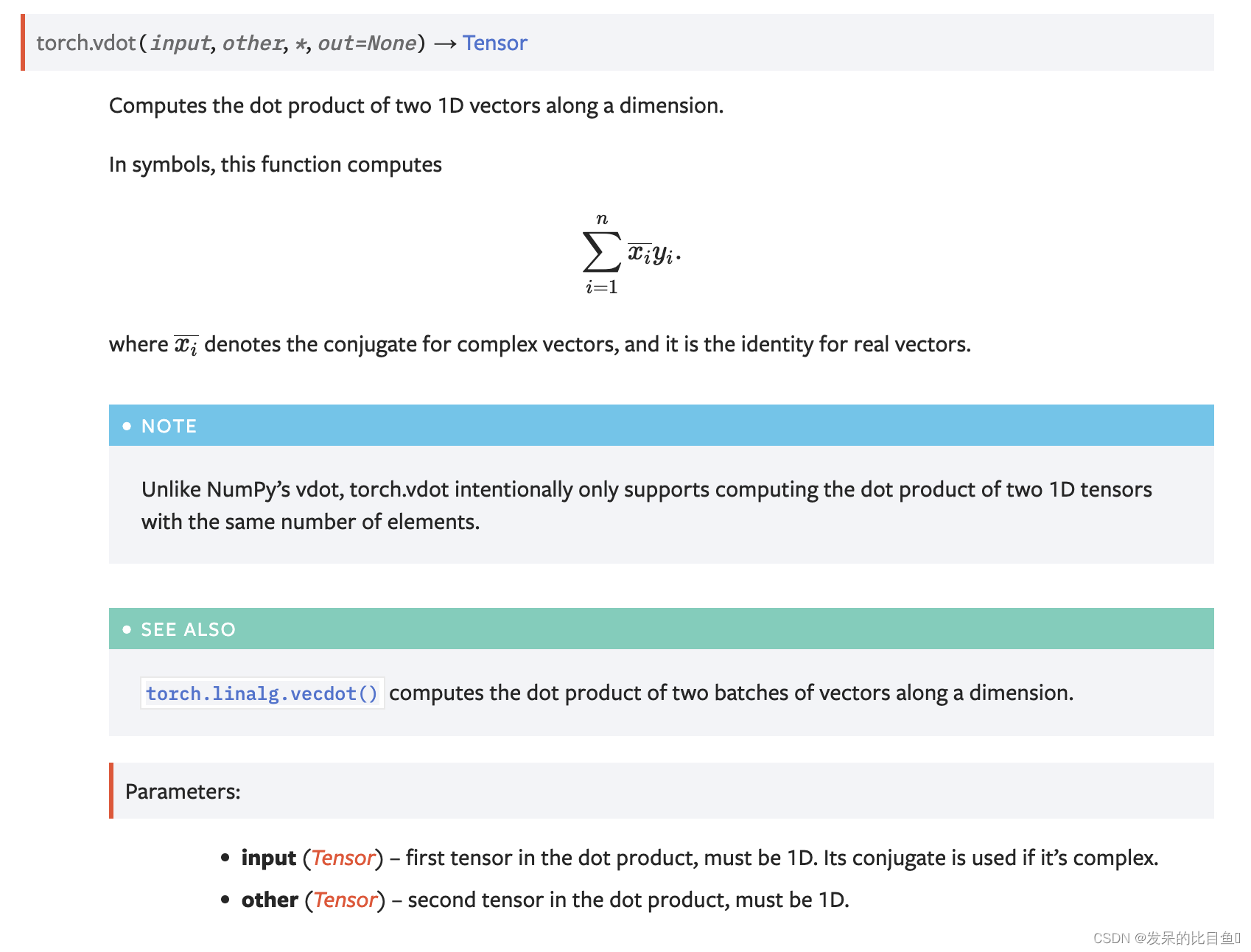
>>> torch.vdot(torch.tensor([2, 3]), torch.tensor([2, 1]))
tensor(7)
>>> a = torch.tensor((1 +2j, 3 - 1j))
>>> b = torch.tensor((2 +1j, 4 - 0j))
>>> torch.vdot(a, b)
tensor([16.+1.j])
>>> torch.vdot(b, a)
tensor([16.-1.j])























 1088
1088











 被折叠的 条评论
为什么被折叠?
被折叠的 条评论
为什么被折叠?










